




Home to some of the world’s largest aerospace and defense companies, innovative startups, and next-generation technologies and manufacturing, Arizona is at the forefront of the aerospace and defense industry. With more than 300 days of sunshine annually, a longstanding commitment to supporting the U.S. military and a business-friendly environment, top companies come to Arizona to develop advanced solutions and drive innovation.
Lightcast, 2024 1#
CONCENTRATION FOR GUIDED MISSILE AND SPACE VEHICLE MANUFACTURING

#1
LARGEST OPTICS & PHOTONICS MANUFACTURING JOB GROWTH
Lightcast, 2024
TOP 3
AEROSPACE MANUFACTURING ATTRACTIVENESS
PwC, 2025
TOP 2
LARGEST GUIDED MISSILE AND SPACE VEHICLE MANUFACTURING
Lightcast, 2024
TOP 5
LARGEST EMPLOYMENT IN A&D MANUFACTURING
Lightcast, 2024
How the West Valley Became the ‘It Place’
In this recurring CRE feature, Kim Ryder shares insight into the industry, where the market is going and what’s impacting it.
How Edward Jones Is Reshaping Corporate Philanthropy
This month spotlighting Edward Jones, Tyler Butler’s series explores the myriad ways businesses give back and the positive ways their programs impact our community.

Four of our major A & D businesses help us gain a snapshot view of the
strength of the industry and what bodes for the
9 Guest Editor
Sandra Watson, President and CEO of Arizona Commerce Authority, introduces the “Aerospace & Defense” issue.
10 Feedback


Emily Lorah, Hannah Levos, Amy Singpradith and Trevor Wilde respond to In Business Magazine’s burning business question of the month: What is your company (or industry) doing to strengthen the pipeline for talent to fill employment needs?
12 Briefs
“Electric Vehicles: Trend or Status (Quo) in Arizona?” “Dailies Top Stories,” “Local Standouts Recognized for Achievements and Philanthropy,” “ECM Technologies Disrupting HVAC Service Industry” and “Steel Tariffs and Building Certainty in an Uncertain Market”
15 Startups
“Cross-Border Cultural and Safety Awareness with Travel App GrinGO” and “JHJ Collective Helps Clients ‘Do Good. Go Far.’”
16 From the Top
Chef Patty Titcombe combines rich cultural and culinary traditions into Lasgidi Café.
17 CRE
“How the West Valley Became the ‘It Place’,” “First Walkable Senior Living Community in Old Town Scottsdale,” “Transforming Legacy Buildings into Next-Gen Office Destination” and “New Industrial Campus in Goodyear to Add a Retail Component”
20 Semi Insights
“Arizona’s Semiconductor Surge and the Workforce Struggle Beneath It,” “AI-Fueled Factory Brings National Security and Manufacturing Jobs to Mesa” and “Amkor’s $2 Billion Bet on Arizona Comes with a Commitment to Air Quality”
FEATURES
34
Beyond the Acronym: How Companies Can Rethink DEI without Backlash
Dr. Poornima Luthra explores why, when people view DEI as a threat, they often feel helpless, overwhelmed, inadequate, uneasy, excluded, anxious and insecure.
42 Empowering Employees through Uncertainty
Sam Bolen explores the role of leadership in these times when workplace anxiety is valid and predictable.
43
SRP Offers Tools and Tips for Businesses to Weather Arizona’s Monsoon Season
Erin Thorburn discusses strategies for businesses to prepare for and deal with monsoon-related power problems.
24 Healthcare
“AZ Blue Supports Student Training in Public Health Care” and “Rock View Recovery: Redefining Behavioral Healthcare through Innovation and Community”
26 Technology
“What Makes Development ‘Responsible’ in the Public’s Eyes? A Clue from Data Centers” and “Why Online Booking Is Essential for Modern Businesses”
35 Books
New releases give fresh insights on business thinking.
36 Economy
Joseph Natarelli discusses the role of AI in construction, with applications for project planning, safety and efficiency.
38 Legal
Attorney Guillaume Aimé discusses the need for shareholders’ agreements in closely held corporations.
44 Nonprofit
Richard Tollefson discusses the Giving USA 2024 report that highlights growth amid political uncertainty.
45 Assets
2025 Audi A8
Plus: Owl offers a wise move in conference tech.
46 Power Lunch
Saint Urban Serves Up Comfort
66 Roundtable
Jennifer Kaplan defends reputation as deeper than brand, and founded on integrity.

We’re here to focus health care where it belongs: on you. You deserve the kind of care that goes beyond a chart or a prescription. It’s the kind of care that covers everything you need to live your healthiest life, including support from a whole team of doctors, nurses, and specialists to keep you feeling good. And it’s care that gives you all the benefits of a nationally recognized health care company with a hometown, personal touch.


Editor in Chief, In Business Magazine
RaeAnne Marsh became editorial director of Phoenix-based InMedia Company in 2010 and helped launch Valley-wide business resource In Business Magazine Holding the magazine to strong editorial standards, she says, “New businesses are founded, out-of-staters bring new strengths, established businesses evolve and expand — all of which contributes to the dynamic vitality that I see as the mission of In Business Magazine to be the voice of and vehicle to nurture. It is my challenge to ensure each edition is packed with relevant information on a broad spectrum of issues, aimed at a readership that runs the gamut from entrepreneurial startup to major corporation.” Marsh was awarded 2024 Small Business Journalist of the Year from the U.S. Small Business Administration, Arizona District.
Guest columns are feature articles presented as a special, limited series as well as regular, ongoing series in In Business Magazine

Guest Columnist – Social Impact
A long-time corporate social responsibility practitioner, Tyler Butler is known for her expertise in creating, launching and developing successful social impact programs. Her commitment to rallying people together to make a positive difference has created sustainable signature programs empowering people to give back in myriad ways globally. She operates under the ethos of “each one teach one,” and so her contributions to In Business Magazine provide her with an outlet to share the best of what companies are doing to aid humanity — shedding light on good corporate citizens and share stories about the magic they are creating through their generous outreach efforts.

Guest Columnist – Commercial Real Estate
Kim Ryder is a dynamic commercial real estate executive with extensive experience in managing multi-million-dollar, complex projects and the build-out of more than 54 million square feet of retail and commercial space. Ryder has started several business lines in her career, most notably launching Thrive Real Estate and Development groups. Her career in the thrift industry extends over 25 years and led her team to expand the Goodwill real estate portfolio by more than 100 locations, having leadership over more than 400 transactions. Her expertise in thrift real estate has made her a well-known resource of knowledge

Bruce Weber
Guest Columnist – Capacity
Bruce Weber sees In Business Magazine as a valuable forum for topics relevant to our business and nonprofit community. “I am deeply interested in organizational capacity and what makes organizations successful and impactful in the work they do. In my work in the community for more than 16 years, I have worked with all sizes of organizations and leaders in helping their businesses grow and expand their impact. My previous careers with Microsoft and Hewlett Packard involved working with business integration partners to design strategies to engage new markets. In today’s complex world, I enjoy exploring the possibilities and opportunities that change can bring.”
Guillaume Aimé is a senior associate attorney at Gallagher & Kennedy in Phoenix and focuses his practice in the areas of securities and business transactions. (“Understanding Shareholders’ Agreements in Closely Held Corporations,” page 38)
Sam Bolen, SHRM-SCP, THRP, is the director of human resources consulting at REDW Advisors & CPAs. (“Empowering Employees through Uncertainty,” page 36)
Jennifer Kaplan is the president and CEO of Evolve PR & Marketing, Arizona’s largest public relations firm. (“Your Reputation Is Your Résumé – Guard It Well,” page 66)
Poornima Luthra, Ph.D., an associate professor at the Copenhagen Business School, is a globally recognized author. (“Beyond the Acronym: How Companies Can Rethink DEI without Backlash,” page 34)
Joseph Natarelli is the national construction leader at CBIZ. He has more than 35 years of experience, including advising on mergers, acquisitions and divestitures. (“AI in Construction,” page 36)
Amber Smith is CEO of Pipeline Connects, focused on reducing poverty by growing access to career pathways. (“Arizona’s Semiconductor Surge,” page 20)
Richard Tollefson is founder and president of The Phoenix Philanthropy Group, an Arizona-based international consulting firm. (“Giving Rates Surpass 40-Year Average,” page 44)
Editor in Chief RaeAnne Marsh
Associate Publisher Nico Pacioni
Graphic Design Matt Fischer
CONTRIBUTING WRITERS
Guillaume Aimé Jimmy Rhoades
Sam Bolen Ryan Ross
Tyler Butler Kim Ryder
Mike Hunter Nina Sharpe
Jennifer Kaplan Amber Smith
Poornima Luthra Erin Thorburn
Joseph Natarelli Patience Titcombe
Stephanie Quinn Richard Tollefson
Kimberly Raduenz
ADVERTISING
Operations Louise Ferrari
Business Development Raegen Ramsdell
Louise Ferrari
Cami Shore
Events Amy Corben
WTSM TV STUDIO
General Manager Chris Weir
More: Visit your one-stop resource for everything business at inbusinessphx.com. For a full monthly calendar of business-related events, please visit our website.
Inform Us: Send press releases and your editorial ideas to editor@inbusinessphx.com
President Camron McCartney
Editorial Director RaeAnne Marsh
Financial Manager Tom Beyer
Office Manager Allie Jones
Accounting Manager Todd Hagen Vol. 16, No. 8 In Business Magazine is published 12 times per year by InMedia Company. POSTMASTER: Send address changes to InMedia Company, 45 W. Jefferson Street, Phoenix, AZ 85003. To subscribe to In Business Magazine please send
Corporate Office InMedia Company 45 W. Jefferson Street Phoenix, AZ 85003 T: (480) 588-9505 info@inmediacompany.com www.inmediacompany.com
or mail to the address above. All letters sent to In Business Magazine will be treated as unconditionally assigned for publication, copyright purposes and use in any publication, website or brochure. InMedia accepts no responsibility for unsolicited manuscripts, photographs or other artwork. Submissions will not be returned unless accompanied by a self-addressed, stamped envelope. InMedia Company, LLC reserves the right to refuse certain advertising and is not liable for advertisers’ claims and/or errors. The opinions expressed herein are exclusively those of the writers and do not necessarily reflect the position of InMedia. InMedia Company considers its sources reliable and verifies as much data as possible, although reporting inaccuracies can occur; consequently, readers using this information do so at their own risk. Each business opportunity and/or investment inherently contains certain risks, and it is suggested that the prospective investors consult their attorney and/or financial professional. ©2025 InMedia Company, LLC. All rights reserved. No part of this magazine may be reproduced or transmitted in any form or by any means without written permission by any means without written permission by the publisher.





In Business Magazine is a collaboration of many business organizations and entities throughout the metropolitan Phoenix area and Arizona. Our mission is to inform and energize business in this community by communicating content that will build business and enrich the economic picture for all of us vested in commerce.

Debbie Hann, Interim CEO Arizona Small Business Association Central Office (602) 306-4000 www.asba.com
Steven G. Zylstra, President & CEO Arizona Technology Council One Renaissance Square (602) 343-8324 www.aztechcouncil.org

Kristen Wilson, CEO AZ Impact for Good (602) 279-2966 www.azimpactforgood.org

Terri Kimble, President & CEO Chandler Chamber of Commerce (480) 963-4571 www.chandlerchamber.com
Joanna Horton McPherson, President NAWBO Phoenix Metro Chapter (480) 289-5768 www.nawbophx.org

Robin Arredondo-Savage, President & CEO Tempe Chamber of Commerce (480) 967-7891 www.tempechamber.org
Our Partner Organizations are vested business organizations focused on building and improving business in the Valley or throughout Arizona. As Partners, each will receive three insert publications each year to showcase all that they are doing for business and businesspeople within our community. We encourage you to join these and other organizations to better your business opportunities. The members of these and other Associate Partner Organizations receive a subscription to In Business Magazine each month. For more information on becoming an Associate Partner, please contact our publisher at info@inbusinessphx.com.
Ahwatukee Foothills Chamber of Commerce ahwatukeechamber.com
Arizona Chamber of Commerce & Industry azchamber.com
Arizona Hispanic Chamber of Commerce azhcc.com
The Black Chamber of Arizona phoenixblackchamber.com
Economic Club of Phoenix econclubphx.org
Glendale Chamber of Commerce glendaleazchamber.org
Greater Phoenix Chamber of Commerce phoenixchamber.com
Greater Phoenix Equality Chamber of Commerce gpglcc.org
Mesa Chamber of Commerce mesachamber.org
North Phoenix Chamber of Commerce northphoenixchamber.com
Peoria Chamber of Commerce peoriachamber.com
Phoenix Metro Chamber of Commerce phoenixmetrochamber.com
Scottsdale Area Chamber of Commerce scottsdalechamber.com
Scottsdale Coalition of Today and Tomorrow (SCOTT) scottnow.com
Surprise Regional Chamber of Commerce surpriseregionalchamber.com
WESTMARC westmarc.org
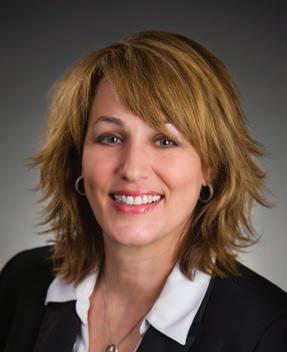
Sandra Watson is an economic development professional with more than 30 years of leadership experience in business attraction and expansion, innovation, entrepreneurship, economic policy and workforce development. Watson currently serves as the president and CEO of the Arizona Commerce Authority, a public-private partnership that leads statewide economic development. The ACA has successfully landed 1,360 companies that have committed to creating more than 312,000 quality jobs and investing more than $194 billion in new capital in the state. azcommerce.com
Arizona’s Aerospace and Defense industry is taking off, reaching new heights with significant investments — and even more growth on the horizon. Industry leaders across the state are developing cutting-edge technologies, creating skilled jobs, and ensuring our national defense. As one of Arizona’s fastest-growing industries, Aerospace and Defense represents an immense opportunity to strengthen our economy.
As home to a robust supply chain of global A&D leaders and exciting innovators, Arizona is at the epicenter of the nation’s defense industry, demonstrated by the state’s top three ranking for aerospace manufacturing attractiveness and top five ranking for largest A&D manufacturing employment.
To expand Arizona’s aerospace and defense leadership, last month, the ACA and the Southwest Mission Acceleration Center launched the Arizona Office of Defense Innovation, a strategic initiative that will support and grow the state’s A&D industry and expand Department of Defense missions in the state. Housed within the ACA, the ODI will serve as a critical hub to coordinate efforts between state agencies, defense contractors, academia, innovators and the DOD while encouraging the development and deployment of emerging technologies.
For this month’s cover story, In Business Magazine reached out to four of the biggest companies in the A&D space in Arizona. Input from Honeywell, Boeing, General Dynamics and Raytheon provide insights on Arizona’s A&D industry and future outlook.
This month’s feature article addresses a timely topic for employers navigating sensitive cultural issues. Dr. Poornima Luthra provides helpful tips and guidance to support all employees in her article “Beyond the Acronym: How Companies Can Rethink DEI without Backlash.”
Sam Bolen covers another issue for businesses in her article “Empowering Employees through Uncertainty.” The article explores the toll of uncertainty experienced by a workforce and offers practical options for company leadership.
This month’s thought-provoking Roundtable feature takes a close look at the value of reputation in business. In “Your Reputation Is Your Résumé – Guard It Well,” Jennifer Kaplan underscores the distinction between brand and reputation as she emphasizes the foundational importance of integrity.
Other articles touch on Arizona’s electric vehicle momentum and the value of online booking to modern businesses. This month also reprises the Arts & Culture guide so well-received when it debuted last year.
As we begin a new season of arts and cultural events, In Business Magazine presents the Arts & Culture Guide for 2025/2026 season to showcase some of our great organizations and provide information on how to connect to enrich your lives and help impact our great community.
It is my pleasure to work with In Business Magazine in its efforts to inform and strengthen our local economy. Please enjoy this August edition of In Business Magazine.
Sincerely,

Sandra Watson President & CEO Arizona Commerce Authority

Editor’s Note: This question generated input also from:

Amy Singpradith Chief Human Resources Officer/SVP
Copper State Credit Union Sector: Banking
Please visit August’s Feedback entry on our website to learn this company’s experience of workforce development. www.inbusinessphx.com
FEEDBACK QUESTION: Let us know what you want to know from the Valley’s top business leaders. editor@inbusinessphx.com
For all past Feedbacks go online to inbusinessphx.com and see what Valley executives think on various business topics.
What is your company (or industry) doing to strengthen the pipeline for talent to fill employment needs?

Talent Acquisition Manager
BioLab Holdings, Inc.
Sector: Medical Manufacturing
At BioLab Holdings, we are committed to raising the standard of patient care — and that begins with the talent we bring on board. In today’s competitive talent market, a strong acquisition strategy and a sustainable pipeline are essential as we continue to scale rapidly. To meet evolving workforce needs, we focus on several key initiatives.
Through our internship program, we recruit future innovators across Research & Development, Sales and Marketing, Lab Operations, and Business Operations, offering students realworld biotech experience. At industry networking events, we build a presence at conferences and networking groups help us connect with passive candidates, enhance employer branding and expand our reach. Through university events and job fairs, we collaborate with state colleges, allowing us to attract emerging talent for internships and entry-level roles while increasing awareness.
Most importantly, we strengthen our employer brand by showcasing our mission-driven work, collaborative and innovative culture, and commitment to a stellar candidate experience throughout the recruitment lifecycle.
BioLab Holdings, Inc. biolabsciences.net
As talent acquisition manager at BioLab Holdings, Hannah Levos leads full-cycle hiring to build mission-driven teams that elevate brand, culture and innovation. With experience in both corporate and agency settings, Levos drives data-informed recruitment strategies that align with BioLab's regenerative health mission. She focuses on sourcing talent that enhances employer branding, fosters growth and reflects the company's values — fueling expansion through creative, values-based hiring.

Executive Director
Roman Empire Agency
Sector: Health Care and Social Assistance
Our company works to be proactive in strengthening the pipeline to find qualified staff, following the requirements of state and insurance guidelines for providing direct services to clients. By building a strong brand on platforms such as Indeed and Glassdoor, our goal is to attract qualified candidates who will impact our clients on a micro-level and the community on a macro-level.
Roman Empire thrives on displaying the values and mission to serve those individuals with developmental disabilities. The basis of building a strong team is ensuring that our candidates and employees receive top training in learning how to provide quality services to our clients. To attract new talent, we have partnered with universities to speak to students during different workshops, as well as rely on social media.
Roman Empire not only actively seeks to practice diversity and inclusion with clients, but also within our hiring practices. We practice transparency and want our candidates to have a smooth and positive experience during the recruiting and onboarding process.
Roman Empire Agency romanempireagency.com
Emily Lorah is a board-certified behavior analyst with a master's degree in marriage and family counseling from Liberty University. She has been working with individuals with disabilities since 2008 and has experience working both directly with clients and as administrative support. Lorah has worked with Roman Empire Agency since 2015 and has gained a lot of knowledge while working with the owner, Gabriela Salcido.
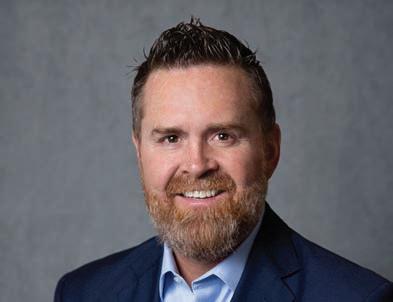
Founder & CEO
Wilde Wealth Management Group Sector: Financial
Within the finance industry, experts predict that within the next 10 years, we will be short approximately 100,000 advisors to meet the U.S. demand. Currently, the industry is top-heavy, with the bulk of advisors nearing retirement themselves. As a result, independent firms like ours are focused on recruiting and retaining talent in a way that has never been done before.
If entering the industry just 15 years ago, one worked at a big firm and built a book of business under its banner. The focus was strictly wealth management. However, with the rise of independent firms, advisors now have the opportunity to create their own business on their own terms. Smart firms like Cetera Financial Group are investing significantly in myriad strategies to support independent advisors, aligning them with their platform while giving them the freedom they desire. And very smart firms are recognizing the need to provide support to advisors beyond marketing, branding and technology, focusing on providing integrated, coordinated services so advisors can meet all of a client’s needs.
Wilde Wealth Management Group wildewealth.com
Trevor Wilde is the founder and CEO of Wilde Wealth Management Group, which provides comprehensive retirement, investment, real estate, insurance, legal and tax planning services all under one roof through in-house partners and local affiliated firms. Recently, Wilde was honored by Forbes in its 2025 BestIn-State Wealth Advisors, ranking No. 1 overall in Arizona. He was also recently named to Barron’s annual list of top advisors nationwide.

Here are the stories with the most views over the past 30 days (prior to press time) that were features in our In Business Dailies, which hits email inboxes every weekday at 9:30 a.m. Sign up today: at www.inbusinessphx.com/dailies-signup
Growth & Enterprise | Cover Story | July 2025 Headquartering Here: Benefits of Having Your Business in Arizona
by RaeAnne Marsh
“Some of the most prominent companies in the world have chosen Greater Phoenix as a headquarters location. From direct economic contribution and job creation to advancements in technology and healthcare, these companies are integral to Greater Phoenix’s quality of life and economic opportunity,” says Chris Camacho, president and CEO of Greater Phoenix Economic Council.
Legal & Regulations | Legal | June 2025
The Changing Workplace: The Outcomes and Challenges of Return-to-Office Mandates in 2025
by Sarah Watt
In the years following the globally disruptive COVID-19 pandemic, employers have explored variations of work arrangements to balance the demands of their businesses with the needs of their employees’ personal lives. Among the lessons learned through the pandemic was, many jobs have the potential to be performed remotely.
Positions | inbusinessphx.com | June 27 2025 Chris Camacho’s Next Chapter: From Regional Transformation to Global Innovation at Axon
by Mike Hunter
For nearly two decades, Chris Camacho has been a driving force behind Arizona’s economic renaissance. Rising from business development roles in Yuma to helming GPEC as President & CEO since 2015, he has built a reputation for visionary leadership and formidable achievement. Now, he embarks on a new journey—joining Axon in a senior executive capacity, bringing his deep expertise to the company’s expanding global headquarters in Scottsdale.
Economy & Trends | Cover Story | June 2025
Economic Protections: Ensure Strong Profits in Down Times
by RaeAnne Marsh
The landscape surrounding businesses today is challenging, strewn with hurdles and dilemmas. But not without opportunities as well.

Electric vehicles accounted for 8.1% of U.S. auto sales in 2024 — a record high. Yet despite steady adoption, a cloud of skepticism lingers. Political divides and cooling growth rates have raised doubts: Are EVs the next standard, or just a well-marketed fad?
In Arizona, where long commutes, extreme heat and wide-open highways dominate, the answer is becoming clearer. Automakers and local dealers are betting big on EVs — not because they’re trendy, but because the landscape is shifting.
Across the state, Ford dealers are installing high-speed charging stations as part of the BlueOval Charge Network, connecting customers to a broad range of public charging providers like Tesla, Electrify America and ChargePoint.
“This investment is partly practical — serving a growing number of electric vehicles — but it also plays a strategic role in easing concerns about charging infrastructure while bringing more people to our lots,” says Tom Somerville, Ford’s marketing director of enthusiast vehicles. “Fast chargers at dealerships open the door for new customer relationships, even with non-Ford EV owners.”
Arizona’s hot climate and rapidly growing metro areas like Phoenix, Scottsdale and Tucson also make home charging more appealing — especially when paired with solar. That’s why dealers are also reshaping their operations to better serve EV customers. Sales teams are being retrained to speak fluently about battery range, charging cycles and ownership benefits, while service
departments are adjusting to lower-maintenance electric drivetrains that need fewer repairs.
EV buyers in Arizona are no longer early adopters. Models like the Ford Mustang Mach-E (the second-best-selling electric SUV in the U.S.) and the F-150 Lightning (the top electric pickup) are converting everyday drivers.
These consumers want more than innovation; they want comfort, reliability, safety and a price point that makes sense. Ford’s strategy reflects that. Its marketing emphasizes traditional vehicle values, not futuristic hype.
To combat one of the biggest hurdles — range anxiety — Ford launched its Power Promise in 2024. It includes complimentary home chargers with standard installation for new EV buyers. For road trips, the vehicle’s navigation system taps into the BlueOval Network to identify available charging stations and even processes payments automatically.
Arizona dealers are investing heavily in EV infrastructure, knowing the payoff may be years away. But in a state where solar energy, sprawl and innovation intersect, EVs may be less of a passing trend and more of an inevitability. After all, in the desert, it’s not about following trends — it’s about staying ahead of the curve. —Jimmy Rhoades
Ford Motor Company ford.com/electric




Nox Group’s Greg Ayres an EY US Winner
Greg Ayres, president and COO of large-scale industrial contractor Nox Group, won the prestigious Ernst & Young LLP Entrepreneur of the Year 2025 Pacific Southwest Award. Under Ayres’ leadership, Nox Group has emerged as a national force in the construction of mission-critical infrastructure, including data centers, advanced manufacturing facilities and water/ wastewater treatment plants. noxgroup.us
Cameron Molloy Brings Distinction to Visit Mesa Visit Mesa communications specialist Cameron Molloy has been named to Destinations International’s “30 Under 30 Class of 2025” for Destinations International, the largest and most respected association of destination organizations, convention and visitors bureaus and tourism boards. destinationsinternational.org visitmesa.com
Terracon’s Don Clark a Distinguished Engineering Alumnus
Donald R. Clark, P.E., a senior principal and senior consultant in the Phoenix office of engineering consulting firm Terracon, is the recipient of the 2025 Distinguished Engineering Alumni Award from the University of Colorado in Boulder. Clark, who has been with Terracon for more than 30 years, established Terracon’s Denver (1992) and Phoenix (1995) offices. terracon.com
Camelot Homes Earns Top Honors
Camelot Homes was honored to receive two top awards at this year’s PCBC Gold Nugget Awards, the oldest and most prestigious residential design awards in the nation. The Scottsdale-based, family-owned homebuilder won for Residential Detached Collection of the Year – The Collection and Best Interior Design of a One-of-a-Kind Home – The Gallery at The Collection. camelothomes.com
Wilde Wealth a Top Advisor in Nation Wilde Wealth Management Group, an award-winning financial services firm that provides comprehensive retirement, investment, real estate, insurance, legal and tax planning services all under one roof, is No. 60 nationally on Barron’s 2025 Top 250 Private Wealth Management Teams and is one of only two local firms to rank in the top 100. wildewealth.com
ECM Technologies’ ThermaClear® product earned the Phoenix-based leader in HVAC preventive maintenance and efficiency honors as the Most Innovative Business of the Year in the 2025 Champions of Change Awards. The annual program recognizes trailblazing leaders and organizations that are reshaping Arizona’s business landscape through visionary thinking, bold leadership and philanthropic impact.
ThermaClear® is ECM Technologies’ breakthrough solution to the widespread issue of oil fouling, an often-overlooked cause of HVAC inefficiency and premature equipment failure. The treatment removes oil buildup from heat exchanger coils, restoring optimal heat transfer and maximizing energy efficiency. It also superlubricates compressors to minimize wear and reduce the risk of mechanical failure. By creating a permanent protective barrier within the system, ThermaClear® prevents future fouling, resulting in fewer repairs, lower operating costs and enhanced
long-term reliability. ThermaClear® dramatically improves the efficiency of HVAC systems with one treatment that lasts for the entire lifespan of the equipment, resulting in dramatic carbon footprint reduction and substantial HVAC operational savings of up to 20% annually.
To meet growing demand and maintain consistent service quality, ECM Technologies launched its Preferred Service Network, a national network of certified HVAC service providers trained to deliver ThermaClear® treatments to the highest standard.
Beyond innovation, ECMT is also being recognized for its commitment to the community.
The company has selected Boys & Girls Clubs of America (BGCA) as its charity of choice nationwide, donating ThermaClear® treatments to reduce HVAC-related operational costs across club locations. —Mike Hunter
ECM Technologies ecm-technologies.net
As a second-generation Arizona steel fabricator and founder of Next Level Steel and Next Level Decking, I’m who people call when they want to talk structural steel construction. Or maybe it’s a developer trying to get a gauge on the level of large-scale commercial and industrial developments in the pipeline here in the Valley and beyond. But lately everyone wants to ask me about the same thing: What’s happening with the new tariffs on foreign steel, and how will they affect prices and projects across Arizona?
So far, we haven’t seen a significant shift in material costs. In fact, many foreign structural steel suppliers seem to be absorbing the added tariff costs — for now. Domestic producers haven’t raised prices much either, but that could change.

might ripple through supply chains and pricing. When combined with the ongoing pressure of higher interest rates, the result is a pause across many sectors of construction.
Delta Dental AZ Foundation Supports Nonprofits Statewide
The Delta Dental of Arizona Foundation has awarded grants totaling $799,524 to 39 nonprofit organizations that work with underserved populations of all ages through oral health and nutritional programs. deltadentalaz.com
Most of our structural steel sources have always been U.S.-based, and we’ve reexamined our supply chains to ensure we have additional sources for 100% American-forged steel. But I don’t expect a return to COVID-era supply chain chaos or a lack of materials to meet capacity. What we are seeing is hesitation. Projects that were ready to break ground are being shelved as developers and investors wait to see how tariffs
Despite this, demand remains strong. Contractors need reliable partners who can deliver structural steel and decking solutions quickly, locally, and with consistency. That’s where we come in.
After launching Next Level Steel in Mesa in 2020 (and being named the nation’s 16th fastestgrowing manufacturer by Inc Magazine), we’ve doubled down by launching Next Level Decking in Goodyear. —Brandon Bell, founder of Next Level Steel (www.nextlevelsteel.com) and Next Level Decking (www.nldecking.com)
In 2022, the year ThermaClear® was officially introduced to the market through a series of pilot programs with major facilities across Arizona and beyond, the City of Phoenix became one of the first municipalities in the nation to integrate ThermaClear® into its long-term sustainability strategy.
GrinGO is a leading travel and safety app dedicated to enhancing cross-border experiences for United States travelers into Mexico. Through strategic partnerships and innovative solutions, the GrinGO app provides essential tools and resources for borderless travel, cultural engagement and safety awareness. Key features include auto insurance for Mexico, real-time travel alerts, curated tourism content, emergency assistance resources and direct integrations with government agencies.
“While working in the Arizona Governor’s Office at the Arizona-Mexico Commission and traveling frequently between the U.S. and Mexico, I saw firsthand how outdated and fragmented cross-border travel services were — especially in areas like auto insurance, emergency support and safety communication,” says GrinGO CEO Brian Krupski. “I realized there was a need for a modern, mobile-first platform that could make travel safer and more seamless for Americans going into Mexico.” He founded the company in March 2019.
One of Krupski’s biggest challenges was building trust — both with users and with government agencies in Mexico. Addressing this, he focused on building partnerships with credible institutions such as SECTUR (Mexico’s Tourism Secretariat) and the Ángeles Verdes.
Another challenge he dealt with was navigating the regulatory and cultural differences between the U.S. and Mexico. Says Krupski, “My bilingual and multicultural background helped immensely, allowing me to communicate effectively and

build lasting relationships on both sides of the border.”
Taking to heart the advice to “dive in without hesitation (or you will never start your company) and build something that solves a real problem — and then prove it can scale,” Krupski started with one very specific problem (Mexico auto insurance), validated the market need, and expanded GrinGO’s offerings only after building user trust and agency partnerships. “It’s easy to try to do too much at once; that advice helped me stay focused and strategic,” he shares. —RaeAnne Marsh Are government policies for our Southern border impacting tourism — and GrinGO? CEO Brian Krupski discusses this in the online version of this article, on our website at www.inbusinessphx.com
JHJ Collective is a consulting firm dedicated to supporting organizations that do good for others. Specializing in cause-related marketing strategy and leadership coaching, the firm helps clients amplify their positive impact. With a focus on Brené Brown's Dare to Lead™ methodology, JHJ Collective offers leadership development services that include workshops, team development and personalized coaching for both executives and emerging leaders. JHJ’s approach emphasizes self-awareness, courage, empathy and purposedriven leadership.
“After decades of serving others in the nonprofit sector and working with several media companies throughout my career, I decided I could make an even larger impact on my own. Over the past few years, I helped build a startup where I learned more than I realized about starting a business,” says owner Jill Hawkins Johnson, who founded JHJ Collective in December 2024.
The biggest challenges in starting and growing this company have been “time, time and time,” Hawkins says. “With so much need in our community, there is only so much

time in the day. I lead with vulnerability and pour my soul into what I am doing, for every meeting and every client.” As a venture studio, JHJ Collective was supporting entrepreneurs from the ideation stage to the validation stage and then, eventually, to commercialization. Simultaneously, Johnson was training in Houston, Texas, on the principles of Brene Brown's leadership.
Johnson believes there will never be a shortage of businesses that want to give back to their community (even in the toughest times) and there will never be a shortage of good stories to share publicly. “Someone must always connect the dots for both and be a good leader while doing it,” Johnson says. “I believe that that is the sweet spot for JHJ Collective: Do Good. Go Far.” —RaeAnne Marsh
JHJ Collective jhjcollective.com
In addition to its digital platform, GrinGO operates a network of destination marketing websites and event production that promotes Mexico tourism and culture. By curating unique travel content, producing culinary and cultural events and partnering with government tourism agencies, GrinGO brings the richness of Mexico’s destinations to life for U.S. travelers.
JHJ: SUCCESS IS PERSONAL
“I think it is important for people to understand that success is personal and it looks different for everyone,” says JHJ Collective owner and founder Jill Hawkins Johnson. Noting that some people view success as a number in their bank account and others the amount of hours they put in per day, she shares, “For me, I wanted to have time wealth. I have had the opportunity to do just about everything I have wanted in my career. I have been in the wealthiest rooms and in the most povertystricken communities. I have celebrated with celebrities and helped others begin their career. There wasn't much left on the list except being my own boss and being a present mother. That is my personal success. “Once you figure out what your success looks like, you build from there.”
With storytelling and food, Chef Patty leads from the heart to build business on taste of home by Patience
(Chef Patty) Titcombe
My journey to entrepreneurship wasn’t a straight line — but it was always guided by heart. After earning a master’s degree in health care administration and building a successful career in the field, I felt a pull I could no longer ignore: a calling to share the rich culinary traditions of my Nigerian roots with the wider world.
I decided to take the leap and start Lasgidi Cafe after repeatedly hearing friends and community members say how hard it was to find African food in Phoenix. That gap sparked something in me since I was also missing that delicious taste of home. I began by cooking for small gatherings for friends and neighbors. Living in a small town, word got around and people started to request catering orders. I continued the journey, testing recipes and learning what resonated. I wasn't just serving food; I was starting conversations and bringing culture to the table. In-home catering grew into cooking classes, popup dinners, tent set-up selling small bites at farmers markets and, ultimately, our food truck.
Launching a Nigerian food business in a place where most people weren’t familiar with the cuisine came with real challenges. I had to build trust and awareness from scratch. To do that, I leaned into what I knew: hospitality and education. I created pop-up dinners that didn’t just feed people but explained to them what they were eating. I hosted cooking classes that walked our customers through the dishes. I shared the story of each spice, ingredient and cooking method — through Instagram captions, printed flyers and conversations at the window of my food truck. I realized that food was my medium but storytelling was my power.


Building Lasgidi Cafe also meant learning fast — especially about the behind-the-scenes parts of business. I’ve had to deal with supply chain disruptions, city permit challenges and the constant hustle of staffing and scheduling. I remember driving across town in the summer heat because only one store carried the ingredient I needed. Every challenge taught me something — and every win reminded me why I started. There's a
That authenticity fostered connection. Within the first year, Lasgidi Cafe had built a loyal following — not just among foodies, but among people who were craving cultural connection. My first customers came from word-of-mouth. I gave away free samples at African-owned businesses, reached out to local markets and event organizers, and asked friends to spread the word. I joined community festivals like Uncorked wine, USA Today Food and Wine, and holiday markets — making sure Lasgidi Cafe had a presence anywhere people were gathering and eating.
The response was incredible! We were soon catering for corporate events and cultural festivals across the Valley. I hadn’t anticipated that the Cafe would become a touchstone for everyone — but that’s exactly what happened. For many, Lasgidi Cafe became a soft landing — a place to hear familiar music, share stories around food and enjoy the comfort of food from home.
Innovation has always been part of my approach. I launched Jollof with Instructions as a way to bring jollof rice into people’s homes in a new way. Customers pick up a partially prepped pan and finish it themselves using my step-by-step
instructions. It gives them a sense of ownership and connects them to the process. That same spirit led me to launch Chop Jollof, a live cooking and storytelling series where I invite influential Nigerians to cook with me and talk about food, culture and identity. These ideas came from listening to my customers and wanting to deepen our connection beyond the plate. I tested small versions of each idea before launching more formally, and every step was community-driven. Our community Kwanzaa event was built from those same guidelines and principles. Honoring the principles of Kwanzaa and connecting it to food and culture helped make our community event a success.
I do not do this work alone. I’ve been fortunate to hire an incredible team who believe in the mission of Lasgidi Cafe. My leadership philosophy is rooted in collaboration and empowerment. I give my team space to contribute ideas and take ownership, and I make sure we celebrate our wins together — big or small.
Today, I’m excited about what’s next. I’m actively planning a brick-and-mortar cafe and lounge in downtown Phoenix. It’ll be more than a place to eat — it’ll be a hub for culture, music and connection.
At Lasgidi Cafe, I want everyone to feel welcome — whether they grew up eating jollof rice or are tasting it for the first time. Food is a bridge between worlds, and at our table there’s always room for more.
Lasgidi Cafe lasgidicafe.com
The West Valley is no longer the stepchild of the Phoenix metro area. by
Kim Ryder
Over the past decade — and increasingly so in the past few years — West Phoenix and the broader West Valley of metro Phoenix have emerged as epicenters of explosive commercial and residential growth. Fueled by a potent confluence of expansive land availability, robust infrastructure investments and escalating demand, this region is rapidly transforming from suburban fringe to a dynamic economic powerhouse. The West Valley is no longer the stepchild of the Phoenix metro area.
Affordable Land & Strategic Infrastructure: The West Valley — encompassing communities such as Buckeye, Goodyear, Surprise and Surprise-adjacent West Phoenix — sits on vast tracts of developable land. This area is home to more than 1.8 million residents and is projected to grow at twice the national rate over five years. The Phoenix Metro Area, including portions of the West Valley, remain some of the fastest growing areas in the country. The region boasts more than 21 million square feet of industrial space under construction, emerging as a hotspot for distribution, healthcare and advanced manufacturing.
Major infrastructure projects like Loop 303, Loop 202 and the Metrocenter light-rail extension — which opened the elevated Metro Parkway station in Jan 2024 — have dramatically improved connectivity, making remote suburbs like West Phoenix and Surprise significantly more accessible. The planned State Route 30 will add another level of ease to access.
Economic Anchors & Corporate Investment: Major employers are relocating to the West Valley in droves. Taiwan Semiconductor’s $165-billion investment near Phoenix has created additional growth, while companies like Amkor, Microsoft, Amazon, Microsoft-backed factories (e.g., White Claw, Red Bull cans) and data centers follow suit. Sprouts Farmers Market recently broke ground on a 180,000-square-foot mixeduse campus in North Phoenix’s CityNorth district, indicating that even corporate headquarters are increasingly drawn westward.
LARGE-SCALE RESIDENTIAL PROJECTS ARE RISING ACROSS WEST PHOENIX SUBURBS
Surprise 295: a soon-to-rise development on 295 acres featuring 945 single-family homes and 240 multifamily units, approved in mid-2025.
Teravalis (formerly Douglas Ranch): This master-planned community in Buckeye spans 33,800 acres and is slated to include 100,000 homes housing up to 300,000 people, with residential lots hitting the market in 2024 and construction underway).
Other sustainable communities like Vistancia, Elianto and Mystic are flourishing in Buckeye and Peoria.
BUILD-TO-RENT & MULTIFAMILY SURGE
West Phoenix’s rental market is also booming. Build-to-rent (BTR) projects—specifically single-family homes developed for rent—make up a third of new apartment deliveries since 2020.
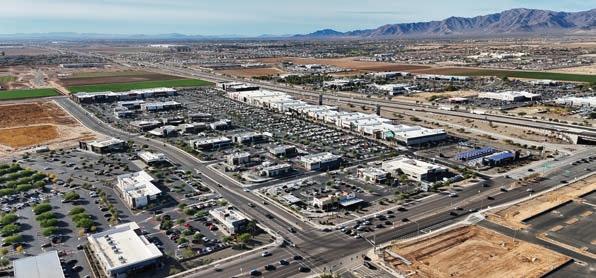
Additionally, multifamily construction west of the I-17 corridor is surging, with over 2,600 units underway or in planning.
Retail Powerhouse: West Valley retail is experiencing an unprecedented boom. Shopping centers like Verrado Marketplace, Prasada in Surprise, Laveen Towne Center, The BLVD in Avondale and GSQ in Goodyear are either open or under construction — collectively delivering more than 1 million square feet of retail space by 2028. Retail vacancies have plunged to around 5.3%, and foot traffic has nearly returned to pre-pandemic levels by late 2024.
Industrial & Logistics Hub: The West Valley’s logistical infrastructure is expanding rapidly. CapRock Partners broke ground in 2025 on Phase 2 of CapRock West 202 Logistics: an 825,000-square-foot Class A warehouse complex in Southwest Phoenix, adding to the already 2.5 million square feet built in Phase 1. In Buckeye, the Paloma Vista Logistics Center also entered Phase I in 2024, supporting growing supply chain demand.
The West Valley now accounts for more than 50% of new home permits in the Phoenix metro area.
Builders issued more than 17,600 single-family home permits through August 2024 — up 34% from the previous year.
Median new home prices in the West Valley ($364,000) remain more affordable than metro averages ($440,000) .
West Phoenix and its neighboring West Valley have shifted from backwater suburbs to a bustling metropolitan growth engine. Anchored by massive industrial campuses, logistical hubs, multifamily and single-family housing and retail destinations, the area is redefining the Greater Phoenix identity.
As infrastructure continues to expand — be it light rail, highways or corporate campuses — the region will likely sustain its explosive growth. However, planners and policymakers must continue addressing water security, balanced growth and community cohesion to ensure this record development yields sustainable, long-term benefits for residents and businesses alike.
Keep an eye on the West Valley; it’s now the “It Place” to be and that doesn’t look like it’s changing anytime soon!
Sitting on vast tracts of developable land, the West Valley — encompassing communities such as Buckeye, Goody ear, Surprise and Surprise-adjacent West Phoenix — is home to more than 1.8 million residents and is projected to grow at twice the national rate over five years.

Kim Ryder is a dynamic commercial real estate executive with extensive experience in managing multi-million-dollar, complex projects and the build-out of more than 54 million square feet of retail and commercial space. Ryder has started several business lines in her career, most notably launching Thrive Real Estate and Development groups. Her career in the thrift industry extends over 25 years and led her team to expand the Goodwill real estate portfolio by more than 100 locations, having leadership over more than 400 transactions. Her expertise in thrift real estate has made her a well-known resource of knowledge. tsginc.com/thrivedevelopment-group

Empire Group of Companies, through its luxury urban infill division Aspirant Development, and Brinkmann Constructors broke ground recently on The Osborn, the first high-end senior living community in Old Town Scottsdale to offer walkability to the area's rich array of dining, retail and cultural amenities. The 226-unit, 420,000-square-foot project will deliver a full continuum of care, from Active Adult to Memory Care, within a vibrant, urban setting.
“Our goal with The Osborn is to create a luxury senior living community that doesn’t feel isolated or institutional – but rather, connected, elevated, and experience-driven,” said Geoffrey Jacobs, managing partner of Aspirant Development. —Mike Hunter builtbyempire.com brinkmannconstructors.com

Phoenix-based developer George Oliver, in partnership with Ascentris, has launched plans for Arbor Old Town, a new luxury office redevelopment in the heart of Old Town Scottsdale.
Spanning more than 360,000 square feet across three buildings and six acres at the prominent corner of Scottsdale and Indian School roads, the project will introduce the district’s first hospitality-driven campus, combining next-generation workplace design with high-touch amenities and immersive outdoor environments.
The project spans a three-parcel assemblage purchased by George Oliver and Ascentris in 2024. Its three buildings allow George Oliver to create a significant new office campus with a substantial interior garden complex in the heart of the Old Town submarket. —Mike Hunter georgeoliver.com ascentris.com

Now online, Goodyear AirPark Phase I is a 1.6 million-square-foot, six-building Class A industrial project. Full-service commercial real estate firm Lincoln Property Company and Scottsdalebased Harvard Investments designed the development to meet Phoenix’s evolving demand for mid- to large-scale industrial space, has come online. It was delivered with full utilities infrastructure and zoning for industrial and commercial use, making it a leading speed-to-market option.
“Goodyear AirPark delivers at a time when Goodyear is advancing on all fronts as a true live-work-play community,” says Lincoln Senior Executive Vice President David Krumwiede. “This project adds a strong industrial base and a unique retail offering to that growth, making Goodyear attractive to the major employers and industries that create long-term stability.”
That retail offering, Estrella Gateway, will span 63 acres and up to 15 pads to accommodate full-service retail tenants upon completion. Located at the main entrance to Estrella Mountain Ranch and accessed by the MC 85 and future State Route 30/Tres Rios Freeway, Estrella Gateway will offer everyday convenience for park employees and the almost 440,000 residents living within a 10-mile radius.
Development of the retail pads at Estrella Gateway will kick off with construction of a Quick Trip Travel Center, situated on approximately five acres at the southwest corner of Estrella Parkway and State Route MC 85. Lincoln and Harvard completed the land sale to QT during Q1 2025. Construction on the travel center is scheduled to begin during Q4 2025.
Goodyear AirPark is strategically located between the Estrella Mountain Ranch
master-planned community, PhoenixGoodyear Airport and Goodyear Civic Square — or GSQ — the city’s emerging urban core. It also sits adjacent to the future Tres Rios Freeway/State Route 30, a planned reliever for I-10 running 29 miles south of I-10 from the Durango Curve on I-17 to State Route 85 in Buckeye.
Located within the 565-acre Goodyear AirPark master plan, Goodyear AirPark Phase I is ultimately slated to include approximately 7 million square feet in up to 20 buildings. Targeting mid- and large-scale users, Phase I includes six buildings ranging from 81,000 to 775,000 square feet. Each building features up to 40-foot clear height, a total of 327 dock-high and 28 drive-in doors, private truck courts, and generous car and trailer parking in a secured lot.
“Goodyear AirPark adds critical industrial inventory to one of the Valley’s fastest-growing submarkets,” says Lincoln Executive Vice President John Orsak. “Its divisibility to 20,000 square feet and expansive connectivity support logistics, advanced manufacturing and semiconductor uses of all types and sizes, as well as data centers — a market sector in which Phoenix ranks as a U.S. leader.” Designed and constructed by awardwinning firms Butler Design Group and Stevens-Leinweber Construction, Inc., Goodyear AirPark sits three miles south of Interstate 10, minutes from the awardwinning Estrella Mountain Ranch community and Goodyear Ballpark. It is bordered by Estrella Parkway, Bullard Avenue and State Route MC 85, a high-volume east/west trucking route connecting Goodyear with Mexico. —Mike Hunter
harvardinvestments.com lpc.com

• More than 1 million skilled workers needed globally in semiconductors by 2030 (McKinsey & Company, 2023)
• At least 70,000 projected demand in the U.S. (McKinsey & Company, 2023)
• 50% year-overyear growth in semiconductor job postings in Phoenix (Lightcast, 2024)
• Only 18 of every 100 Arizona ninth graders earn a credential (National Center for Education Statistics, 2022)
• Just 28% of technician jobs require a four-year degree (Georgetown University Center on Education and the Workforce, 2020)
and the workforce struggle beneath it by
Amber Smith
The semiconductor industry — foundational to everything from smartphones to fighter jets — is facing a widening talent gap. As global demand accelerates, driven by artificial intelligence, electric vehicles and national security needs, the shortage of skilled workers has become one of the most urgent threats to stalling our innovative ability to lead in defense and competitiveness. In Arizona, where billions in chip manufacturing investments are pouring in, we are seeing firsthand what global demand and supply building looks like in real time. This workforce gap is emerging as a defining challenge we have to quickly solve.
Semiconductor manufacturing demands a highly specialized workforce — engineers, technicians, cleanroom operators and supply chain experts — yet education and training systems nationwide have struggled to keep pace. McKinsey & Company projects the global industry will need more than one million additional skilled workers by 2030. In Arizona, the Arizona Commerce Authority reports more than $205 billion in semiconductor investment since 2020, creating more than 25,000 direct jobs across manufacturing, packaging, R&D and workforce training. Home to major firms like TSMC, Intel and Applied Materials, Arizona continues to attract significant federal and private-sector investment — fueled by broad bipartisan support for the industry’s role in national security and economic growth. However, preparing a talent pipeline that matches this scale remains a challenge, especially for roles requiring specific technical skills or hands-on training.

As CEO for Pipeline Connects, Amber Smith is focused on reducing poverty by growing access to career exploration and pathways for children and adults alike — by disrupting the workforce development space, creating ecosystems where job seeker skills align with industry needs. She graduated from the University of Arizona (twice), is the chair of the Pima College Foundation Board and was a founding board member/past chair of the Southern Arizona Defense Alliance. pipelineconnects.org
In Arizona, fewer than 38 out of every 100 ninth graders go on to complete any form of postsecondary credential, and of those, only 18 complete a credential. Among the graduates, many graduate with qualifications that don’t align with high-growth or high-demand sectors, not to mention emerging industries like semiconductors. Technician roles, for example, are in high demand across every industry. In the case of semiconductors, entry-level jobs that once required an associate’s degree now often require industry-specific certifications or applied experience, allowing talent to skill up with less time and financial investment. This begins to spotlight credentials and ripe industry pathways primed for growth — especially for those starting at the bottom floor — because there are many directions for upward mobility.
At the same time, the challenge is that the career pathways into the semiconductor industry are often unclear — both because they diverge from the traditional four-year college track that society has long emphasized, and because the industry itself has rapidly evolved. Many of the most indemand roles don’t require a bachelor's degree but do require industry-specific training or credentials that are not published in areas where students are exploring options. This challenge is compounded by a broader lack of awareness about career pathways in general, making it even harder for students and job seekers to navigate emerging roles that are unique to

this sector. Career transitions are frequently fragmented and slowed by a lack of access, awareness or guidance. A 2023 report from Pearson, a global education company that studies workforce trends, estimates that inefficient education-tocareer transitions cost the U.S. economy $1.1 trillion annually — more than 5% of GDP.
The challenge in Arizona is twofold: Not only must the state grow the number of skilled workers entering the semiconductor industry, it must also ensure those individuals can clearly identify and access the pathways that lead to these careers. That urgency is already playing out on the ground. Labor market analytics firm Lightcast reports that semiconductor job postings in the Phoenix region rose nearly 50% year-over-year — outpacing the supply of talent to fill them.
This shortage affects far more than the typical aforementioned roles in the semiconductor sector. It extends to logistics coordinators, cleanroom technicians, metrology specialists and process operators — critical roles that support the industry’s growth and represent a majority of talent demand. Our largest gap in workforce typically remains in rural areas or untapped populations where there are few career insights and career-connected learning to key industries. We knew, more than a decade ago, that without a coordinated, statewide approach to workforce development, Arizona would risk falling short of its full potential as a national player in technology innovation, even before semiconductors became a necessary challenge to solve.
But in this challenge lies opportunity. Arizona is building a more connected talent ecosystem — through partnerships that link education, workforce systems and industry. The answer isn’t just more programs. It’s smarter alignment — and it’s already underway.
The U.S. economy loses $1.1 trillion each year — more than 5% of GDP — due to inefficient transitions from education to careers, according to Lost in Transition by Pearson, an education research and publishing company (Pearson, 2023). Arizona’s semiconductor workforce gap is a direct example of this national challenge.








A new kind of factory is coming to Mesa — designed not just for production, but for national resilience. Hadrian, a California-based company using artificial intelligence to modernize manufacturing, has announced plans for a 270,000-square-foot advanced facility in the city's Pecos Advanced Manufacturing Zone, known as Factory 3. The project is estimated to cost $200 million and is expected to create 350 high-quality jobs.
"Hadrian's decision to build Factory 3 in Mesa further establishes our city as a leading destination for innovation and advanced manufacturing," says Mesa Vice Mayor Scott Somers. "This significant investment will strengthen our local economy and reinforce our position as a critical hub in America's manufacturing resurgence."
Rather than focus solely on outputs, Hadrian's approach centers on how things are built. The company combines software with skilled labor to create "fullstack factory autonomy" for defense and aerospace customers, producing everything from precisionmachined parts to mission-critical assemblies.
"We view our job as to reindustrialize the country," says Chris Power, Hadrian's founder and CEO. "It's these systems' autonomous factories and a new American workforce that's the real product."
The Mesa site will be four times the size of Hadrian's first facility in California, marking a strategic expansion into sectors such as welding, casting and additive manufacturing. Arizona, Power notes, offered fast permitting, reliable infrastructure and a workforce eager to build.
"This isn't about replacing workers," he says. "It's about enabling them with both technology and the American spirit."
As Hadrian breaks ground in Mesa, the facility is slated to open in 2026. Hadrian's project is just another example of how Mesa is joining a growing network of communities helping to reestablish U.S. manufacturing strength, one high-tech facility at a time. —Stephanie Quinn Hadrian hadrian.co

Imagining the future of Arizona’s semiconductor industry evokes pictures of clean rooms and cutting-edge tools. However, Amkor Technology also wants clean air to be in that picture.
The Tempe-based company, already one of the world’s largest providers of outsourced semiconductor packaging and testing, plans to invest $2 billion in a new advanced facility in Peoria. Two thousand local jobs are expected to be created, as well as an expanded domestic capacity in a sector increasingly seen as vital to national security and economic resilience.
And Amkor executives are quick to point out it’s not just about capacity. It’s about doing it right.
“We are proud to be an American company and have been based right here in Arizona for decades,” said David McCann, senior vice president at Amkor, during a recent public webinar. “It’s important to us to be responsible stewards of the land, air and water.”
The new facility will house state-of-the-art semiconductor testing and packaging operations, but it’s the environmental infrastructure that may set it apart. According to McCann, Amkor’s cleanroom air quality will exceed that of most hospital operating rooms. That’s not just a claim; it’s a design requirement.
Amkor uses a layered system of HEPA filters to remove fine particles from incoming air. Then, the facility’s airflow pushes particles downward from ceiling vents through floor-level collectors, where they’re filtered again before the air is recirculated. Employees in the cleanroom wear full-body suits, nicknamed “bunny suits,” and pass through air showers before entering, minimizing the chance of contaminants.
It’s all standard practice in semiconductor manufacturing, but Amkor is taking it a step further when it comes to what happens next: emissions control.
Before any air is released back into the environment, it’s cleaned through a two-part system. First, a water scrubber dissolves remaining particles. Then, the air is heated to eliminate organic compounds, odors and pollutants, breaking them down into carbon dioxide and water.
To ensure reliability, Amkor has built redundancy into the system, featuring duplicate units that enable maintenance and provide backup. And most notably, the company has pledged to keep its emissions at least 50% below all applicable local, state and federal limits.
Amkor’s broader sustainability roadmap included the creation of this Peoria facility. The company has set a verified net-zero greenhouse gas emissions goal for 2050, with a 55% reduction in absolute Scope 1 and 2 emissions by 2033. These targets are certified by the Science Based Targets initiative (SBTi), and the company also adheres to frameworks such as the Responsible Business Alliance, the Responsible Mineral Initiative and the Sustainability Accounting Standards Board. Amkor has also pledged to reduce water use and waste generation by 20% by 2030.
It’s an ambitious plan for a company that continues to scale operations in lockstep with U.S. semiconductor policy. With more companies reshoring and expanding advanced packaging capabilities in North America, the need for robust infrastructure and public trust has never been greater.
Arizona has tremendous momentum within the semiconductor industry, having surpassed $200 billion in investments and showing no signs of slowing. Peoria's gain is just another example of that momentum. Facilities like Amkor’s don’t just add jobs and capacity; they raise the bar for environmental responsibility, public engagement and regional planning.
As McCann noted, the company will continue to host webinars to keep the community informed throughout the construction and operational phases. “We want to make sure people have a clear understanding of how we operate and what we value,” he said.
Amkor’s message is clear: Clean chips start with clean processes. And, in the race to build America’s semiconductor future, Arizona is once again leading by example. —Stephanie Quinn
Amkor Technologies amkor.com


The Bridge Fellowship Program — offered through the Mel and Enid Zuckerman College of Public Health at the University of Arizona Health Sciences — helps students learn how public care, like Medicaid, is set up, paid for and provided. Learning how these systems work behind the scenes enables them to better guide their patients who depend on this care.
This is significant, as Medicaid plays a big role in care across Arizona, covering more than one-third of the people in the state. And, thanks to an $80,000 gift from Blue Cross Blue Shield of Arizona Health Choice, 10 students are getting a closer look at how care works beyond the clinic.
Each student received $6,000 to support this training. They also took part in the 2025 Rural Health Conference in Flagstaff, where they met with care teams, policy leaders, and public health experts.
“This fellowship helps students see the full picture of care, not just how to treat patients, but how care reaches them,” says Heather Carter, Ed.D., CEO of Blue Cross Blue Shield of Arizona Health Choice. “By learning how programs like Medicaid shape access, they’re better prepared to support the people who rely on it every day.”
This work is part of AZ Blue in Action, an effort by Blue Cross Blue Shield of Arizona to improve health across the state. AZ Blue in Action helps create lasting change in areas with the greatest need. —Mike Hunter
azblue.com/about-us/az-blue-in-action publichealth.arizona.edu

Rock View Recovery, a North Phoenix-based behavioral healthcare organization, is transforming how addiction and co-occurring disorders are treated by merging evidence-based practices with trauma-informed care, brain-centered technology and a community-driven continuum of support. Founded on the principle that sustainable recovery requires more than symptom management, Rock View Recovery is structured as both a treatment center and an extended recovery community — a model that reflects the company’s forward-thinking approach to healthcare delivery.
At the core of Rock View’s model is a residential treatment facility that provides intensive, immersive clinical support. The program utilizes cutting-edge clinical modalities, including neurofeedback and neurosequential therapy, in conjunction with traditional therapeutic approaches such as individual counseling, group therapy and medication management.
What differentiates Rock View Recovery from other providers is its dual emphasis on clinical innovation and long-term engagement. “We don’t just discharge clients after a fixed program and wish them well,” says a representative of the executive team. “We’ve built an ecosystem around ongoing recovery, and that’s where our Recovery Community comes in.”
The Recovery Community functions as a stepdown or extended care option. Clients in this program transition from residential care into sober living homes — all structured environments where they continue participating in therapy, job and life skills development and community activities. This model has been instrumental in addressing chronic relapse, one of the industry’s most persistent challenges.
From a business perspective, this hybrid approach creates diversified and recurring revenue streams while
maintaining a high standard of care. The residential center and recovery homes share integrated staffing and oversight systems, enabling operational efficiency without compromising quality. With a staff of 20 and growing, Rock View has built a multidisciplinary team that includes licensed clinicians, behavioral health technicians, a nurse practitioner and a medical director. The treatment center is also designed to attract individuals and families seeking premium services. Amenities include a full gym, golf simulator, pickleball courts, a cold plunge and a Zen garden — features that support a whole-person healing philosophy. “We’ve invested not only in clinical excellence but in creating a space where people feel inspired to heal,” the executive adds.
The market demand for high-quality behavioral healthcare continues to grow, and Rock View Recovery is positioning itself at the intersection of medical treatment and human connection. With its focus on trauma-informed care, neuro-science-backed modalities and a culture of accountability, the organization is filling a critical gap in Arizona’s treatment landscape.
Importantly, Rock View’s approach reflects broader trends in the healthcare sector: an emphasis on continuity of care, outcome tracking and reducing recidivism. By aligning treatment outcomes with long-term support, the organization is contributing to both the clinical and financial sustainability of the behavioral health model.
As the industry shifts from reactive to preventive and holistic treatment frameworks, Rock View Recovery offers a compelling case study in how innovative service design and thoughtful business strategy can create meaningful change — for both clients and the field of healthcare at large. Ryan Ross, co-founder of Rock View Recovery (treatment.rockviewrecovery.com)


















Honor is what motivates our team of dedicated healthcare professionals. Through passion and purpose, we come together to ensure every patient is provided with the best possible care. honorhealth.com
Industrial projects often face fierce local resistance, but data centers are proving to be a surprising exception. According to the Data Center Neighborhood Survey Report from Airedale by Modine, a critical cooling specialist for data centers, 70% of Americans are comfortable with a data center within a few miles of their home, and 21% are even okay with one located less than a mile away. That level of acceptance stands in stark contrast to the typical “not in my backyard” reaction to most industrial development.
So, what sets data centers apart?
The survey points to a few key factors. For those who expressed discomfort with data centers, concerns centered around energy use (63%), noise pollution (60%) and potential declines in property value (52%). These concerns aren't insurmountable. They're actionable design challenges that responsible developers can address through energy-efficient cooling systems, noise reduction technology and thoughtful site selection.
The survey uncovered what actually improves public perception: meaningful local investment. More than 60% of respondents said their opinion of a nearby data center would improve if the developer invested in local infrastructure, education or services. Only 4% viewed those investments negatively.
This suggests that responsible development is about more than minimizing harm. It's also about actively contributing to community progress.
With the AI boom driving exponential demand for digital infrastructure, the data center industry has an opportunity to lead by example. Developers across all sectors should take note. Communities want transparency, environmental responsibility and a stake in the benefits.
The message from the public is unmistakable, providing a clear path for developers across all sectors. Investing in communities earns something money can’t buy: public trust. —Kimberly Raduenz, with Airedale by Modine (www.airedale.com)
Data Center Neighborhood Survey Report from Airedale by Modine airedale.com/ 2025/05/21/data-center-neighborhood-survey-report
In a city as fast paced and connected as Phoenix, consumers now expect convenience, speed and flexibility, especially when booking services. Gone are the days of having to pick up the phone to schedule an appointment. If a business doesn’t facilitate booking online, it could be losing out on a revenue boost of between 34% and 125%.
For business leaders who need more convincing, here’s why businesses need to add this functionality to their online presence:
Offers an improved customer experience: Online booking systems create a seamless, personalized customer experience, encouraging repeat visits and word-of-mouth referrals. Rather than spending time on phone calls for information or reservations, customers can complete the process quickly and efficiently online.
Advanced booking systems go beyond basic scheduling by remembering customer preferences, offering suggestions based on previous interactions, and allowing users to create profiles for faster future bookings. This personalized experience increases convenience and encourages customer loyalty by making clients feel valued.
Provides 24/7 accessibility for clients: A recent survey found that more than 60% of consumers expect 24/7 customer service. An online booking system supports this demand by making it easy for clients to schedule or reschedule appointments at any time, regardless of business hours.
This level of accessibility ensures businesses don’t lose potential customers due to limited availability or missed calls. It also proves beneficial for companies with clients across different time zones, reducing friction in the booking process and increasing customer satisfaction.
Increases real-time availability: Handling bookings manually throughout the day can significantly reduce productivity. An online booking system frees up valuable time for business owners and staff, allowing them to focus on core activities such as project planning, customer service, and day-to-day operations. By simplifying service requests, eliminating the need for back-and-forth communication and providing an organized record of all appointments, online systems streamline internal processes. Many online booking platforms also offer advanced meeting room scheduling features, such as automatically syncing bookings with calendar apps to avoid
double-booking, and payment integration to streamline service payments.
Boosts conversions and reduces missed opportunities: Boosting sales and reducing missed opportunities is a priority for most businesses. While marketing, SEO and analytics all play an important role, online booking systems enhance these efforts by converting interest into action.
Offering 24-hour booking options increases the likelihood of securing appointments. Additionally, these systems often include features like cross-selling related services during the booking process and facilitating dynamic pricing based on demand. Offering incentives, such as small discounts for pre-paid or online bookings, can further drive conversions.
Lowers the no-show numbers: No-shows and last-minute cancellations result in substantial revenue loss. In the first half of 2023, U.S. small and medium-sized businesses lost more than $27 billion due to missed appointments.
A comprehensive online booking system can mitigate these losses through automated reminders via SMS or email. These reminders demonstrate a business’s respect for its customers’ time while reducing the chance of forgotten appointments. These platforms also often allow clients to easily reschedule, ensuring a time slot is not entirely lost.
Improves data collection and client insights: Customer data is a powerful asset, and online booking systems collect vital information such as booking history, preferences and contact details. This data allows businesses to understand customer behavior, identify popular services and optimize marketing and operations.
By analyzing trends, companies can create timely promotions or special offers for highdemand periods or encourage bookings during slower times. Personalized reminders, exclusive offers and loyalty incentives based on customer history enhance retention and satisfaction. Plus, these insights can support targeted campaigns and improved service delivery.
Whether operating solo or with a team, any business seeking to remain competitive in a digitalfirst world would be well advised to implement an online booking feature. It’s an investment that offers measurable returns in customer satisfaction and business growth.
—Nina Sharpe













This soaring economic sector is well-grounded by
RaeAnne Marsh
Aerospace & defense is interwoven in our state’s economy with its extensive range of manufacturing and engineering, from aircraft to optics, weapons systems to drone detection, and parts to software.
Four of our major A & D businesses help us gain a snapshot view of the current strength of the industry and what bodes for the future.

Boeing, in Arizona for more than four decades, has established itself as a cornerstone employer here. Its Mesa facility is the production hub for the AH-64 Apache program but also houses fabrication centers specializing in electrical wire bundles, composites and metals. “With nearly 5,000 employees and an estimated $1 billion in annual economic impact, Boeing Arizona taps into a robust network of local suppliers to deliver goods and services to a worldwide market,” says Mark Gaspers, director of government operations for the Central region. “Boeing’s operations significantly contribute to the aerospace industry, focusing on innovation and sustainability while ensuring a strong talent pipeline to support growth.”
Honeywell’s presence here dates back to 1942. Its Aerospace business unit builds aircraft engines, auxiliary power units and avionics systems among which are flight management and safety systems, navigation systems, space and satellite systems, control systems, wireless connectivity and SATCOM systems, and power systems — for a variety of aircraft. Honeywell Aerospace hardware and software solutions enable next-generation lifesaving runway safety technologies, help modernize air traffic control systems and enable seamless wireless connectivity for better inflight experience.
“Headquartered in Phoenix, Honeywell Aerospace products and services are found on virtually everything type of aircraft,” says Ben Driggs, chief commercial and strategy officer of Honeywell Aerospace Technologies. “Honeywell technology helps enable everything from commercial airliners and business jets to general aviation and military aircraft like the F-35. Honeywell Aerospace technology has also flown on every U.S.-crewed space

mention since NASA’s inception. Honeywell Aerospace is also involved in developing technologies for the emerging Advanced Air Mobility market, including electric propulsion and autonomous systems.” Reporting the company’s Aerospace business generated $15.5 billion in revenue in 2024, he notes, “Honeywell is in the process of separating into three companies, with Honeywell Aerospace slated to become an independent, publicly traded company based in Phoenix, Arizona, in the second half of 2026.”
Raytheon currently employs more than 12,500 people in Arizona. “We have seen growth in demand centered around our manufacturing operations — production and factory support roles — in Tucson driven by increased customer demand and the program lifecycle, with several larger programs transitioning from development to production,” says Sam Deneke, president of Raytheon’s Air and Space Defense Systems business. The company’s current openings in Tucson are primarily assembly/test and production workers, which account for nearly half of current open positions. Another quarter of open positions are early professional roles, and a quarter are senior professional roles, primarily for E&E, mechanical and systems engineers.
Gaspers cites aerospace engineers, software developers and manufacturing technicians as among the diverse range of skilled professionals Boeing needs to maintain its competitive edge, and notes Boeing’s proactive approach of collaborating with partners from a cradle-to-career perspective. “We recognize how critical it is to engage students from a young age to encourage curiosity and help build foundational skills in STEM fields, as well as build career pipelines for other critical support functions like supply chain and finance,” he says. “We also reap the benefits of Arizona’s robust higher education system.”
He credits these partnerships for enabling Boeing to create a strong talent pipeline that meets the evolving demands of Arizona’s growing aerospace and defense sectors. “We are proud of our strong relationships with local partners, including the Mesa Public School District, Arizona Science Center, Arizona State University, University of Arizona, Maricopa County Community College District and Embry-Riddle Aeronautical University.”
Boeing’s involvement in internship and STEM training programs provides hands-on experience as well as pathways to employment. A notable example Gaspers points to is the partnership between Honeywell Aerospace Technologies and the East Valley Institute of Technology to establish a STEM Academy in Mesa. “This academy offers training and certifications for high school

students, aligning curriculum development with industry needs to strengthen Arizona's aviation and advanced manufacturing workforce pipeline. By collaborating early in curriculum development, we ensure that training meets current and emerging industry demands, creating valuable opportunities for prospective students across the region.”
Raytheon likewise sees value in working with the school system. According to Deneke, “We are partnering and investing in our K-12 system and higher education, particularly University of Arizona and Arizona State University, to ensure we have a ready workforce that can step onto our campus day one. That allows us to bring and keep jobs here, which strengthens the economy and our community.” A few of Raytheon’s other partnerships are State of Arizona @Work, Veterans Administration and local Arizona military bases (David Monthan Air Base and Luke Air Base). “We partner with them in a variety of capacities, including hiring events, training/education and internships.”
General Dynamics is also focused on the pipeline for talent. “We have a comprehensive summer intern and college hiring program, a local scholarship program and active military outreach to attract top talent. We have many community partnerships that help us connect with job seekers to share the career opportunities at GDMS,” says Chris Brady, General Dynamics Mission Systems president, naming some of the company’s key initiatives to ensure it has the diverse talent needed to sustain growth and positively impact its economic strength. “At General Dynamics Mission Systems in Scottsdale, we frequently hire for a range of positions, including software engineers, systems engineers, hardware engineers, program managers, manufacturing production operators, and engineering technicians.”
With approximately 7,500 people in its employ in and around Phoenix, Honeywell focuses on several growth areas to meet current and future workforce needs. “To ensure that the workforce is prepared, we have partnered with the state’s educational system, particularly in skilled advanced manufacturing and engineering,” Driggs says. “For instance, we have developed training programs with the Maricopa Community College system and local high schools. Additionally, our collaborations with Arizona State University, the University of Arizona, and other institutions are vital for creating a robust talent pipeline.” He notes Honeywell is hosting more than 300 high school and college interns in Arizona this summer, “highlighting our commitment to nurturing future talent.”
With a growth strategy that also extends to such key employment areas as digital and AI skills, engineering, manufacturing and operational support, Honeywell is implementing upskilling and reskilling initiatives, fostering

partnerships with educational institutions and launching mentorship programs. “A strategic talent framework is being developed to align workforce capabilities with our business strategies, emphasizing critical skills and innovative learning experiences,” Driggs says.
Specialized training programs are part of the plan at General Dynamics Mission Systems, according to Brady, who names the Engineering Leadership and Manufacturing Leadership programs. Noting that, additionally, GDMS University provides ongoing education and career growth opportunities for GDMS employees, he says, “These efforts help us maintain a skilled workforce that meets the evolving needs of our company and supports our long-term success.”
Many of Raytheon’s efforts are aimed at military veterans, with veteran and military organizations a big part of the workforce partnerships mentioned above. And, says Deneke, “We also provide a variety of trainings to our Skillbridge interns, who work for us while transitioning out of the military, to include things like résumé, job search, resiliency and negotiation training.”
Another important initiative Boeing is involved in is the Future48 Workforce Accelerator, a partnership involving Governor Hobbs, the Arizona Commerce Authority, the Maricopa County Community College District, Chandler-Gilbert Community College and Honeywell. Providing hands-on training to prepare students for in-demand careers in aerospace and defense manufacturing, “The Future48 Workforce Accelerator combines expert-led instruction with practical training to address the growing need for highly skilled aviation mechanics and technicians,” Gaspers

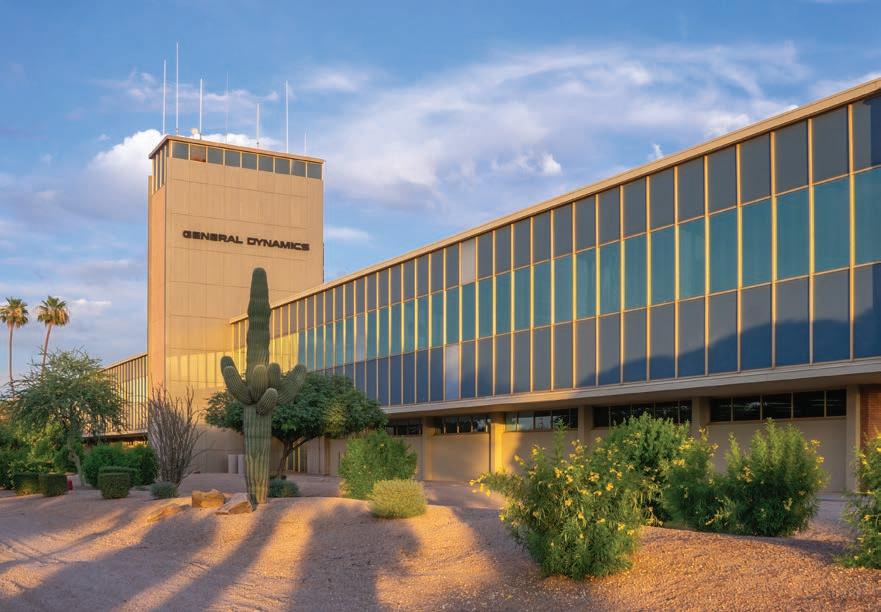
says. “The training facility will feature cutting-edge labs equipped with industry-standard tools and flexible spaces that facilitate seamless transitions between lectures and hands-on learning, including electrical assembly, mechanical assembly and wiring.”
While pointing out that Honeywell employs approximately 7,500 people in Metro Pheonix and has a total estimated payroll of close to $1 billion annually, Driggs notes, “The economic impact of Honeywell Aerospace in Arizona goes well beyond the people we employ. We make purchases in excess of $650 million per year from numerous Arizona-based suppliers.
“We also make an impact through technical coinnovation with our Arizona-based customers and suppliers,” he adds. “We help enable the state’s aerospace eco-system. This high-skill training creates impact beyond just payroll as it increases their demand and competitiveness in the job market.”
Gaspers notes Boeing’s economic impact in Arizona also extends far beyond job creation, as the company generates substantial revenue that strengthens the overall economy of the Valley and the state. For example, he shares, “The AH-64 Apache helicopter program is vital for the U.S. armed forces and allied partners, with its development, research, testing and production in Arizona significantly boosting the state’s economy.”
Statewide, the Apache program provides work for a total of 49 businesses, sustains approximately 13,000 family-
supporting jobs, and generates an estimated $667 million in economic impact. “In Mesa alone, Apache provides work for thousands of machinists, assemblers, engineers and more, and work today continues to develop a modernized Apache that will keep our community focused on protecting our servicemembers for decades to come.”
Reporting that approximately 1,300 Apaches are currently in operation worldwide, serving 18 nations, and that, to date, Boeing Mesa has delivered more than 2,800 Apaches to global customers, Gaspers says, “We continue to see strong, persistent global demand. With the AH-64E in production through the 2030s, the Apache is set to remain the U.S. Army's and its partner nations' primary attack helicopter into the 2060s. Follow-on orders, upgrades, and modernization efforts will ensure the Apache remains in production well into the future.”
General Dynamics Mission Systems’ statewide supplier profile includes approximately $340 million in supplier spend in 2022 through 2024, according to Brady, who reports that approximately 250 Arizona companies currently support GDMS, with 32% large companies and 68% small companies. “It’s the largest General Dynamics Mission Systems site both in number of employees (more than 2,600) and campus size,” he says. With its global reputation for mission-critical, precision electronic systems, it is a major facility for design, engineering, production and testing. Its highly educated and experienced workforce includes approximately 1,400 engineers, and 1,650 of its total workforce of more than 2,600 hold bachelor’s or advanced degrees.
Reporting Raytheon’s spend of $637 million from January 2024 through June 2025, Deneke notes, “We impact the entire supply chain ecosystem through our 600-plus suppliers statewide.” Not to mention its volunteer and philanthropic efforts: Employees of RTX overall in Arizona — which includes Pratt & Whitney and Collins Aerospace along with Raytheon — dedicated 32,000 volunteer hours in 2024, contributing more than $1.1 million in value to nonprofits (as calculated by Independent Sector’s assessment of $34.79 as the current estimated national value of each volunteer hour), and RTX contributed more than $15 million to support local and national nonprofits in Arizona, aiming particularly to improve access to STEM education, enhance community resilience and honor those who serve.
Raytheon’s own footprint in Arizona has grown by about 88,000 square feet since 2022. Says Deneke, “We are actively assessing future growth opportunities in the region. With a current footprint of 4.7 million square feet, this highlights our substantial presence and commitment to the state.”
Gaspers, while crediting Boeing employees with

actively contributing time and resources to support STEM education, veterans and various workforce initiatives through partnerships with Arizona nonprofits, points out that Boeing also stimulates local economies through direct spending on goods and services, along with indirect benefits to suppliers and contractors. “Our commitment to research and development positions Arizona as a hub for aerospace innovation, attracting further investment and enhancing the state’s industry reputation. This growth leads to increased tax revenues and improved quality of life for local communities.” And he notes that Arizona has become the premier location for rotorcraft development and modernization, supported by a robust manufacturing sector and the U.S. Army’s test center at Yuma Proving Ground.
“The U.S. aviation industry is calculated to create a trade surplus of over $100 billion annually for the country, and Arizona aerospace companies are significant contributors to that trade surplus,” says Honeywell’s Driggs. He believes the key to Arizona maintaining the great position it has in this industry is for companies, governments (at all levels — federal, state and local) and educational institutions to work together to encourage policies that support the industry and ensure that Arizona residents have the right skillsets.
“Additionally,” Driggs says, “Arizona also needs to continue to be a good host for the operators of aircraft, maintenance facilities and training schools. Our airports and the rest of the aerospace infrastructure helps to enable the state’s aerospace manufacturers.”
Observing that General Dynamics Mission Systems' products, payloads and systems are deployed on hundreds of platforms across all warfighting domains, Brady sees nearly all domains experiencing a proliferation of platforms and capabilities. “And we are on pace to support our customers across these fronts from our Scottsdale site,” he says. “Consistent with the priorities of the administration and our customers, we are focused on crypto modernization to safeguard missions and secure critical information, proliferated space to enhance warfighter responsiveness and advantage, and avionic electronics essential for autonomous collaboration. Our expansion opportunities center on areas where we possess a mix of discriminating technology, mission understanding, and technical expertise to address emerging threats and warfighter needs.”
Brady points to investments in helping small businesses become compliant with upcoming Cybersecurity Maturity Model Certification requirements as a strategy to help set
up small businesses in Arizona to be ready to work with large prime contractors in the defense industry. He cites the Arizona Manufacturing Extension Partnership center as a great resource for helping small businesses. Says Brady, “Businesses becoming compliant with defense cybersecurity requirements will be attractive and could help drive an increase in business for suppliers in the state.”
Pointing to the valuable employment opportunities and economic growth driven by Boeing’s operations, Gaspers says Boeing is committed to shaping the future workforce and establishing a strong foundation for the aerospace and aviation sectors. “Collaboration among the company, local communities and government entities will be crucial in creating a prosperous aerospace landscape for years to come,” he affirms.
Gaspers credits the State of Arizona for prioritizing key areas such as workforce development, support for innovation and research and development, infrastructure enhancement, and the maintenance of a businessfriendly environment to ensure the continued strength of the aerospace sector. “Creating a favorable business environment is crucial for encouraging investment and innovation,” he says, adding, “Industry organizations also play a vital role in facilitating collaboration among businesses, educational institutions, and government entities, driving growth and innovation within the sector.”
Boeing boeing.com
Honeywell Aerospace honeywell.com/us/en
General Dynamics Mission Systems gdmissionsystems.com/about-us/major-locations/scottsdale Raytheon rtx.com/raytheon


Poornima Luthra, Ph.D., an associate professor at the Copenhagen Business School, is a globally recognized author, TEDx speaker and leading authority on Diversity, Equity and Inclusion. She is the author of four influential books, including Can I Say That? and The Art of Active Allyship, both of which have been named one of Thinkers50’s 10 Best Management Books for 2025 and 2023 respectively.

At the core seems to be a fear of fear itself by Dr. Poornima Luthra
It is 2025, and one would not expect to be experiencing the kind of resistance and backlash that we are toward diversity, equity and inclusion — commonly known by the acronym DEI. It may appear that resistance and backlash to DEI is at its peak right now, but when we look back in time to the women’s rights, civil rights and LGBTQ+ rights movements, resistance and backlash have always been there to varying degrees. In fact, we can think of resistance as a spectrum ranging from hesitancy to engage on one end to outright backlash on the other end. So, what does this mean for companies who are looking to go beyond the acronym and rethink how they approach DEI?
I spent the last two years researching resistance and backlash to DEI. Prior research shows us that resistance toward DEI and broader social change initiatives stem from them being seen as a threat to one’s status, culture or access to resources. What my research shows is that when people view DEI as a threat, they often feel helpless, overwhelmed, inadequate, uneasy, excluded, anxious and insecure. Drawing on the body of research by Paul Eckman and Robert Plutchik, these emotions are expressions of the core human emotion of fear. It is important to note that my research shows it is not just those who are anti-DEI who experience fear and its related emotions, but also those working within the field. But what exactly are we fearful of when it comes to DEI? In my latest book, Can I Say That?, I share the five fears that have emerged from my research that we commonly experience when it
comes to DEI: the fear of change, the fear of getting it wrong, the fear of discomfort, the fear of taking actions, and the fear of lack of positive impact. What is concerning is that we have a fear of fear itself.
To rethink DEI, companies need to first acknowledge the existence of these fears, then take actions to support people with letting go of their fears. Here are five ways companies can enable this to happen.
Clarify what DEI is and is not, to address the fear of change. In many companies today, there is a lack of understanding on what DEI actually is. Many misunderstand DEI efforts to be prioritizing under-qualified people to take on roles in organizations, thereby undermining the belief in meritocracy. Others see it as a zero-sum game with some groups benefiting at the expense of others.
This could not be further from the core intention of DEI, and yet here we are with many who hold this belief thanks to superficial narratives and performative initiatives. Companies need to clarify that DEI acknowledges the existence of systemic inequities that create an imbalanced playing field, making it difficult for qualified and competent people from marginalized backgrounds to gain fair access into workplaces and progress within them.
Companies need to clarify the core purpose of DEI: Diversity is about valuing people’s uniqueness and differences; equity is about levelling the playing field for fairness; and inclusion is
Companies should create safe spaces where people can get comfortable with the uncomfortable — spaces to acknowledge biases and fears. These facilitated spaces should allow for dialogue and discussion while holding space for multiple realities to coexist.
about ensuring that everyone feels a sense of belonging.
Nurture an environment that allows for learning from mistakes, to address the fear of getting it wrong. In a world characterized by a “cancel culture,” even the most well-intentioned ally can hesitate and not engage in DEI efforts for fear of being cancelled. While there are best practices out there, every company’s culture and needs are different, which means that what works in one company may not be as successful in another. We still must try, and the possibility of failure should not hold us back.
Adapting and designing DEI initiatives that meet the needs of the company and add value to the culture of the company, avoiding harming any group while benefiting other groups, is key. Each DEI initiative to foster inclusive workplaces should be seen as an opportunity for growth and learning, grounded in the spirit of constant adaptation for positive impact.
Create space for uncomfortable dialogue and discussions, to address the fear of discomfort. We are creatures of comfort. DEI, however, requires us to acknowledge biases and discrimination, which can make us uncomfortable. We live in a world that is characterized by binary thinking, requiring us to “pick a side” and stick to it.
The problem with that is human behavior and experience is far from binary. It is complex, nuanced and layered. Companies should create safe spaces where people can get comfortable with the uncomfortable — spaces to acknowledge biases and fears. These facilitated spaces should allow for dialogue and discussion while holding space for multiple realities to coexist.
Anchor DEI work in a clear way, to address the fear of taking actions. For many companies, the reasons for engaging in DEI efforts may not be as clear as they assume it to be.
In the months following the murder of George Floyd, many companies jumped on the DEI bandwagon without critical thought or genuine belief. It was just what needed to be done at the time. Now is the time for businesses to find their anchor. Company leadership should ask themselves why they, as a company, are choosing to be engaged with DEI efforts? For some companies, especially in Europe, the answer could simply be compliance with new and upcoming legislation coming into effect. For others, it might be the hope of being more innovative to meet the ever-changing business climate and customer landscape. For yet others, it could be the ethical stance that they desire to be an employer of choice to be able to attract and retain the very best talent. It could also be a combination of any of these. Companies need to find their why and ground their DEI efforts in it. Doing so ensures that employees have an anchor to rely on as they encounter pockets of resistance.
Focus on systemic and cultural change, to address the fear of a lack of positive impact. There is no silver bullet for DEI and no magical solution that is simple enough to solve what is a complex issue. Yet, many DEI initiatives address the challenges in superficial ways, often causing unintentional harm rather than delivering any progress.
Simply creating a website for DEI, hiring more women or people from underrepresented ethnic groups or raising the Pride flag is not going to address the core issues at play. Companies need to focus on systemic and cultural change. This means overhauling their employee life cycle to ensure that biases are being blocked at every step of the way, from the content in the company’s job listings to the interview process to enabling fair performance reviews. It means redesigning product and service development cycles to ensure they are being designed for a more diverse set of customers and ensuring that marketing campaigns are reflective of their diverse needs. To enable and support this systemic change requires cultural change, where every employee sees themselves as active allies to enable a culture where everyone experiences the value of DEI.
When DEI is done right — with a focus on systemic and culture change — everyone stands to benefit.

Drawing on her own first entrepreneurship experience with medical technology startup palmm Co., author Véronique Peiffer gets to the nuts and bolts of three key topics tailored to scrappy entrepreneurs — those who need to be extra resourceful to push their companies to the next phase. They may have an idea they truly believe it, bolstered by extensive market research, but they need significant amounts of funding to develop their product and/or successfully meet regulatory requirements. They will also need help from people with skillsets that complement their own. The Scrappy Entrepreneur helps them know what to expect and even includes simple spreadsheet templates that can save considerable time and money.
The Scrappy Entrepreneur: How to Effectively Lead an Innovation-Driven Startup
Véronique Peiffer, Ph.D.
$31.99
Business Expert Press Available 8/12/2025 168 pages

For those who find a lack of financial resources and time is stifling the growth of their business, Funding Business Growth equips readers with the tools and resources necessary to scale their business using proven financing options. Showcasing real-world success stories, it provides a blueprint for overcoming common obstacles and accessing capital, enabling entrepreneurs to reclaim their time and achieve financial freedom. This book will help them discover if their business is ready to grow and define their objectives for development. It will assist with identifying and understanding the correct sequencing of a business’s growth stages for best results. Readers will explore available funding options and navigate the loan application process to achieve personal growth and look after themselves while they scale their business.
Funding Business Growth: How to secure finance to scale your business
Gus Gilkeson and Nick Wormald
$22.99
Rethink Press On shelves and online 260 pages

In the newly revised second edition of Inflated: How Money & Debt Built the American Dream, veteran investment banker, author and chairman of Whalen Global Advisors LLC delivers the latest installment of his concise history of the United States' monetary system, putting contemporary financial phenomena like inflation and high housing costs into context. Readers will learn to understand how issues like the public debt and the rise of cryptocurrencies can be understood through the lens of how the United States government exploits debt and the monetary system to fund its operations. This second edition of Inflated is an eye-opening discussion of the drastic changes unfolding in the American economy and the even more dramatic transformations that lie just beyond the horizon.
Inflated: Money, Debt, and the American Dream
R. Christopher Whalen
$23.30 Wiley On shelves and online 432 pages
Many DEI initiatives address the challenges in superficial ways, often causing unintentional harm rather than delivering any progress.

Joseph Natarelli is the national construction leader at CBIZ. He has more than 35 years of experience, including advising on mergers, acquisitions and divestitures. He has served as a technical reviewer for the American Institute of Certified Public Accountants’ (AICPA) construction audit and taxation guides for more than two decades and chaired the AICPA National Construction Program Conference Committee 2012–2014.
Applications for project planning, safety and efficiency
by Joseph Natarelli
The construction industry may not be known for breaking new ground (at least when it comes to technology), but it is no stranger to innovation. New tools and techniques are continually emerging or refined to suit modern timelines and tastes. But, as the recent surge in artificial intelligence adoption pushes the boundaries of what is possible, many best-in-class general contractors and subcontractors are taking a bold step into the future.
AI systems have evolved rapidly since they emerged as a novel curiosity generating otherworldly images. Now, construction leaders are relying on AI to enhance their operations, from planning and design to financial analysis and improved decision-making. In this article, we’ll explore how today’s firms can harness AI to drive efficiency that can ultimately lead to better financial health and higher profitability.
One of the primary uses of AI in construction is in project planning and design. AI-powered tools, such as Building Information Modeling (BIM), have revolutionized how projects are conceptualized and planned. These tools create highly detailed 3D models that feature every aspect of a building's structure and systems. They can reveal potential design flaws, carry out clash detection, help professionals optimize materials and layouts, and keep costs in check. All of which can not only reduce the likelihood of expensive errors but also shorten the planning phase, so projects get off the ground more quickly.
AI is also making significant inroads in equipment management. Construction companies are utilizing AI-driven predictive maintenance to monitor the performance of machinery in real-time. Sensors and IoT devices collect data on equipment usage and condition, which AI algorithms analyze to anticipate maintenance needs. This can help minimize downtime, extend the lifespan of machinery and reduce maintenance-related expenses.
AI’s ability to analyze data across multiple sources can make scheduling easier. Advanced scheduling software uses AI to account for weather patterns, labor availability and supply chain logistics to create reliable, accurate and adaptable project timelines.
AI can play a crucial role in enhancing workplace safety. AI-powered cameras can monitor job sites in real-time, identify potential hazards and help ensure compliance with safety protocols. These systems detect potentially unsafe behaviors, such as workers not wearing protective gear, and alert supervisors immediately. By analyzing historical accident data, AI can even identify risk patterns and suggest preventive measures.

AI algorithms can forecast material requirements based on project specifications and timelines, helping to ensure materials are available when needed. AI can also streamline supply chain operations by predicting lead times and identifying reliable suppliers, saving contractors both time and money.
Ensuring high-quality results is always a priority. AIpowered quality control systems use machine learning to analyze images and data from the job site to detect defects and deviations from project specifications. That can improve the overall quality of the construction while safeguarding against the need for costly rework and delays.
Properly configured IT environments allow AI to integrate seamlessly to conduct financial analysis, automate repetitive administrative tasks and generate insightful reports. The successful implementation of AI depends on four factors: (i) thoughtful governance to verify outputs and ensure the ethical use of AI technology, (ii) curated data to ensure the AI is drawing on reliable information, (iii) a closed environment that protects sensitive information, and (iv) an intuitive, secure and capable platform. When it comes to AI use cases, the sky is the limit. However, ensuring these four pillars are central to a business’s AI strategy will determine whether its first foray into AI generates meaningful ROI or is an expensive but unproductive experiment.
Integrating AI in construction is no longer a futurist’s dream; it's a present-day reality transforming the industry. Many best-in-class general contractors and subcontractors already leverage AI to enhance their operations — quality control and automation to financial analysis and cost reduction. Embracing AI is helping these industry leaders set new standards for efficiency, accuracy and safety. As AI technology continues to evolve, its impact on the construction industry will only grow, ushering in a new era of innovation and excellence.
Construction leaders are relying on AI to enhance their operations, from planning and design to financial analysis and improved decision-making.


OF OUR
Goodwill of Central and Northern Arizona turns donations into possibilities by providing no-cost services to more than 30,00 Arizonans annually that help them build a better economic future.
Your purchases and donations help support local, no-cost career services, education, sustainability efforts and housing solutions so Arizonans can build better futures for themselves and their families.
Goodwill of Central and Northern Arizona is a 501(c)(3) non-profit organization dedicated to ending poverty through the power of work! GoodwillAZ.org

Guillaume Aimé is a senior associate attorney at Gallagher & Kennedy in Phoenix and focuses his practice in the areas of securities and business transactions, including SEC reporting, public and private mergers and acquisitions, and entity formation. gknet.com

It’s good business to be prepared for when shareholders who were once best friends don’t agree with each other anymore by Guillaume Aimé
It all starts with a great idea, people getting together over a handshake and starting a business together. Then, one day, times become tough, issues arise, and shareholders who were once best friends don’t agree with each other anymore. Next, one shareholder wants to leave the business, but there is no legal document providing the rules of the road to resolve those issues.
Enter the shareholders’ agreement, a business agreement akin to a prenuptial agreement but for the shareholders of a corporation designed to help shareholders deal with a variety of issues that arise in the course of any business.
This article will discuss what a shareholders’ agreement accomplishes, why it matters in closely held corporations, and key provisions to include and understand.
Simply put, a shareholders' agreement is an agreement among the shareholders of the corporation (sometimes also the corporation itself) that governs the relationship, rights and obligations among the shareholders in operating their business. Shareholders’ agreements exist only for corporations, but an operating agreement for a limited liability company or a limited partnership agreement for a limited partnership typically covers similar matters.
Shareholders are not required by law to adopt and enter into a shareholders’ agreement, but good business management supports the idea of adopting one. Indeed, such an agreement can address how to resolve a slew of issues
before they even arise, removing uncertainty and setting forth expectations among the shareholders at the outset of their relationship.
For example, they are often used to cover the following concerns:
• To identify or limit who may become a shareholder;
• To control voting rights among the shareholders and to otherwise provide for the management of the corporation (instead of a simple majority, it might be wise to require a higher majority to take certain actions like borrowing money or making capital investments);
• To provide a mechanism for resolving disputes or management deadlocks outside of costly litigation;
• To ensure that the remaining shareholders and/or the corporation may acquire the shares of a shareholder when certain triggering events take place, for example, death, disability and termination of employment;
• To provide for minority shareholders a “tag-along” or “cosale” right to participate in any sale of shares by a shareholder or group holding a major interest in the corporation;
• To give a majority shareholder or group a “drag-along” (less bluntly called a “bring-along”) right by which they can compel minority shareholders to participate in share sale transactions that the majority negotiates, so that the majority can deliver all the shares in a sale (or at least all the shares covered by the agreement); and
• To set forth non-competition and/or non-solicitation terms to prevent shareholders from harming the corporation. A shareholders’ agreement can provide for minority shareholders a “tag-along” or “co-sale” right to participate in any sale of shares by a shareholder or group holding a major interest in the corporation.

Decision Making: Generally, decisions in a corporation can be enacted by a simple majority (more than 50%) of the shareholders. There are certain exceptions to that rule as in most jurisdictions a super majority (66.67%) is required to enact decisions related to fundamental aspects of the business. However, a shareholders’ agreement may vary some of those approval thresholds to better fit the shareholders’ desires. For example, decisions regarding financing or corporate structure may be set to require a super majority vote or even a unanimous vote while other less important decisions may require only a majority vote. Consideration should be given to the ownership structure as some of those thresholds are better used to protect minority shareholders from not having a say in major decisions.
Transfers and Ownership of Shares: In a closely held corporation, it is paramount that shareholders get along with each other to run the business. Typically, a transfer of shares requires the approval of the board of directors of the corporation; such a board may not have any representative for the minority shareholders and, accordingly, their interest may not be well protected as they relate to the departure of shareholders.
Additionally, certain triggering events for transfers of shares, such as death or disability of a shareholder, should be covered in the shareholders’ agreement to avoid unwanted surprises. For example, upon the death of a shareholder, his or her ownership is considered an asset and becomes part of their estate. This transfer could lead to the family members of the deceased shareholder becoming shareholder(s) in the corporation without the consent of the existing shareholders. To avoid this scenario, a shareholders’ agreement should provide for a compulsory buy-out, including mandating that the administrator of the estate sell the shares upon the death of a shareholder.
Valuation of Shares: A significant benefit of a shareholders’ agreement is to either set the value of a shareholder’s interests or establish a method of valuation. It is crucial to remove uncertainty in the valuation of the
shareholders’ interests in the event of a death, disability or any other triggering event that does not involve an offer from a third party to acquire the interest with a valuation proposed by such third party.
There are several ways to value the interests, such as:
• Setting a fixed price that is periodically reviewed;
• Setting a formula based on several factors; or
• Appraisals from experts, which such appraisal becomes binding on the shareholders and the corporation once any objections have been resolved (and the objection mechanism and periods are set forth in the shareholders’ agreement to avoid a protracted process).
Exit: A well-written shareholders’ agreement will provide for different exit strategies in the event that the shareholders can no longer be in business together. Agreeing to certain terms from the start of the business relationship can eliminate drawn-out and expensive negotiations later on.
A shotgun clause allows a shareholder to trigger a forced buy-sell scenario, meaning the “triggering shareholder” makes an offer to the remaining shareholders to buy their shares at a specific price. The remaining shareholders can then either accept the offer to sell their shares at that price or are alternatively forced to buy the triggering shareholder’s shares at the same price.
Other clauses, including a drag-along and tag-along clause, can also be included. The former forces minority shareholders to sell their shares in the event that a majority shareholder wants to sell all their shares to a third party; the latter gives the option to minority shareholders to sell their shares along with the majority shareholder.
A shareholders’ agreement can remove a lot of uncertainty and headache in dealing with various business issues and should be adopted when two or more shareholders are in business together. Shareholders should negotiate and adopt one when they begin their business relationship, as it will always be easier to come to an agreement when no tensions exist and they all want the business to succeed.

SPOTLIGHT: EMPOWERING ARIZONA YOUTH THROUGH JA FINANCE PARK®
Edward Jones is investing in the future of Arizona students through its support of Junior Achievement of Arizona and the innovative JA Finance Park® in Tempe. This hands-on financial literacy experience allows middle and high school students to step into adult roles, managing realworld budgets, careers and responsibilities. Edward Jones volunteers serve as mentors during these immersive sessions, helping students understand the fundamentals of saving, investing and responsible spending. The firm’s long-standing partnership with Junior Achievement reflects its belief in early education as a critical pathway to long-term financial strength and equity across Arizona’s diverse communities. jaaz.org/program/ja-financepark
The financial services firm is a leader in partnering for positive impact by Tyler
Butler
In today’s landscape, where companies are increasingly expected to do more than deliver profit, Edward Jones stands out as a financial services firm committed to doing good while doing well. With a legacy that stretches back to 1922, this Fortune 500 company has evolved far beyond its roots serving rural investors. Now headquartered in St. Louis with more than 17,000 financial advisors across North America, Edward Jones is proving that purpose-driven business can be scalable, and impactful.
Under the leadership of Managing Partner Penny Pennington, Edward Jones continues to live its purpose: “to partner for positive impact to improve the lives of our clients and colleagues, and together, better our communities and society.” This mission is deeply embedded in every layer of the firm, informing strategic decisions and community investments alike.
Corporate philanthropy at Edward Jones is not an afterthought; it’s a core part of the culture. That commitment manifests in three impact areas: Partnering for Lasting Financial Strength, Promoting Healthier Futures and Advancing Inclusive Growth. These pillars reflect the firm’s belief that financial confidence, well-being and inclusive opportunity are essential to thriving communities.
“We don’t just write checks. We partner with our communities to drive systemic change,” says Megan Odneal, manager of Community Impact. “Our associates are personally invested in the work because it reflects who we are as a firm.”
This authenticity is exemplified by the grassroots origins of many initiatives, including the powerful "Bag-A-Thon" food drive in Arizona. Inspired by Principal Ken Blanchard’s volunteer work at a local food bank, the effort has grown into a statewide movement. “It was a revelation,” Blanchard recalls of his early experiences. Motivated by witnessing food insecurity firsthand, he rallied his colleagues to action. In 2024 alone, Bag-A-Thon provided more than 27,800 meals to those in need and has collected more than 855,000 pounds of food since its inception in 2007.

Tyler Butler, a trailblazer in ESG and corporate citizenship, has led Fortune 500 sustainability programs, contributed to two IPOs and founded Collaboration for Good. With degrees from ASU, Boston College and Cornell, she writes for top publications and serves as head of Public Affairs for Phoenix Rising FC. collaborationforgood.com
Beyond grassroots efforts, Edward Jones backs national and international causes that align with its mission. A standout is the firm’s partnership with the Alzheimer’s Association. Since 2016, Edward Jones has served as the National Presenting Sponsor of the Walk to End Alzheimer’s. More than 111,000 associates and clients have participated, raising $45 million to date. The firm’s renewed five-year commitment, with a goal of $50 million by 2025, supports early detection, equitable access to care and critical research.
“The impact of Alzheimer’s disease is personal for so many families, including our own,” shares Fay Simpson, National Strategic Partnerships manager. “Our partnership is about providing hope and resources for the long journey this disease brings.”
The firm’s Causes Campaign further reflects its intentionality. Benefitting the United Way and the Local Initiatives Support Corporation, the campaign mobilizes Edward Jones associates to create equitable pathways for

underserved communities. In 2024, the effort raised more than $7.4 million, supporting vital resources for families in cities that include Phoenix, St. Louis, New York and Boston.
“We believe financial education and economic empowerment should be available to all, not just a few,” says Ashley Warner, senior manager of Social Impact. “That belief drives our efforts to ensure everyone has a fair shot at building the life they envision.”
Edward Jones also extends its impact across borders. In Canada, the firm has supported the Terry Fox Foundation’s mission to cure cancer through world-class research. In 2023 alone, corporate and associate contributions totaled more than 258,000 CAD, continuing a three-year partnership that honors the legacy of Canadian icon Terry Fox and his inspiring Marathon of Hope.
Notably, much of this work is supported through the Edward Jones Foundation, which channels resources into nonprofit partners that mirror the firm’s values. Whether it’s improving access to healthcare, advancing economic inclusion or supporting the arts, the foundation amplifies the voices and needs of communities across North America.
“Philanthropy isn’t something we do; it’s who we are,” explains Nina Dawes, executive director of the Edward Jones Foundation. “We are stewards of the trust placed in us, and that means being there when our communities need us most.”
That legacy of trust goes back to founders Edward D. Jones Sr. and his son Ted, who set a tone of generosity and community care that still guides the firm today. From their humble beginnings as “TNT brokers” traveling the Midwest, the company’s ethos remains grounded in personal connection and service.
Today, Edward Jones’ community engagement is not only measurable, it’s deeply meaningful. In an era when impact matters, this firm is showing what’s possible when a business chooses purpose over platitudes. Through strategic giving, employee-led action and enduring partnerships, Edward Jones is helping build stronger, healthier, more inclusive communities — one step, one client and one cause at a time.
Edward Jones edwardjones.com/us-en
For over 40 years, the Arizona Community Foundation has supported nonprofits and students across our state by mobilizing the collective passion and generosity of thousands of Arizonans.
When you are ready to take the next step in your personal charitable giving journey, we are here to help you achieve your goals.
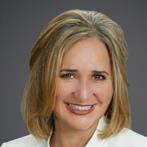
Sam Bolen, SHRM-SCP, THRP, is the director of human resources consulting at REDW Advisors & CPAs. In her role, Bolen guides clients in all functional areas of human resources, including talent acquisition, compliance, policy administration, employee relations, investigations, performance management, training and ongoing support. Her deep experience spans industries, employee cultures and organizational complexity, from startups to large, wellestablished companies. redw.com
Workplace anxiety is valid and predictable by
Sam Bolen
As economic headwinds batter organizations, leaders find themselves juggling risky operational decisions and the very real emotional turbulence experienced by their workforce. For many employees, the threat of layoffs feels ever-present, prompting unsettling questions. Their anxiety is understandable — even rational — in a market where headlines shift by the hour and company priorities must be rewritten overnight.
Leaders must first acknowledge that workplace anxiety is valid and predictable. During volatile times, experienced workers, especially those who have weathered previous downturns, may spot “early warning signs” and wonder if history is due to repeat itself. Others might be tempted to jump ship preemptively in search of greener pastures, further destabilizing the organization.
It is important to recognize that employees respond to layoff uncertainty in varied ways. Factors such as generational differences, level of job satisfaction, financial situation, length of tenure and past experiences with change can all shape their perceptions. For instance, employees facing financial pressures may feel heightened anxiety, while those with longer tenure could be more invested in the company but also more sensitive to past traumas.
In response, a leader’s instinct may be to reassure. However, evidence suggests transparency about uncertainty is critical for fostering psychological safety. Employees can sense when leaders are evasive or insincere, amplifying worry and rumor.
For leaders, it can be tempting to view layoffs as the primary lever for rapid cost reduction in turbulent times. However, sustainable, compassionate organizations benefit from examining every other avenue before making such a consequential decision. Consider options such as offering early retirement packages, eliminating duplicative positions, shifting to incentive-based compensation plans, or revisiting unnecessary operational expenses.
Leaders who proactively audit their operations for these cost-saving measures signal to employees that every possible step is being taken to avoid painful cuts. Not only does this bolster organizational resilience, but it also demonstrates empathy and transparency.
In times of uncertainty, it is not always possible to avoid layoffs. So, what can leaders do in an environment brimming with unknowns?
The answer lies not in promising there won’t be tough times ahead but in equipping employees with clear frameworks to process uncertainty and regain some sense of control — such as reframing worries, mindfulness practices, focused action
planning and models like Stephen Covey’s Worry Wheel, comprised of three distinct areas: the Circle of Concern, the Circle of Influence and, at its center, the Circle of Control.
WORRY WHEEL CIRCLE OF CONCERN
This encompasses everything that one cares or worries about. In current circumstances, this might include economic instability, political differences, external market forces, executive decisions, health crises, crime rates, company budget constraints and more. Stewing in this outer “circle” can lead to paralysis and chronic stress.
Leaders, to navigate the circle of concern, should invite teams to surface their concerns in a structured setting and then help them distinguish between what’s informational (to stay aware of) and what’s actionable.
WORRY WHEEL CIRCLE OF INFLUENCE
This is the domain where actions, choices or efforts genuinely make a difference — whether that is improving job performance, developing new skills, collaborating constructively with colleagues or choosing how we respond to changes around us.
Energy is well spent here as it can drive change, build resilience and reduce anxiety.
Examples of focusing on this area include encouraging continuous learning and upskilling; offering up-skilling courses, webinars or cross-functional project rotations; fostering internal communities or mentorship programs so employees can support each other through uncertain times; sharing opportunities; and brainstorming solutions to shared challenges.
WORRY
The innermost area represents what one can directly manage and decide: one’s own attitude, responses, habits, work output and personal actions. Spending time here yields the highest return on energy.
A person can always control their own behavior, even when circumstances are chaotic.
Leaders should promote micro-habits for stress management such as short walks, focused breaks, and mindfulness practices to help individuals feel grounded despite the chaos. In addition, they should give employees clear visibility on what is happening and what is expected day to day as well as the freedom to manage their own workflow where possible.
HOW THE WORRY WHEEL HELPS WITH WORRY
When individuals focus their energy on concerns they cannot control, productivity plummets and stress balloons; the wheel gets “stuck” and anxiety compounds. However, when they actively identify and act within their Circles of Influence and Control, those zones gradually expand.
With small wins — improving processes, building skills, adjusting attitudes — confidence and competence grow.
The Worry Wheel, adapted from Stephen Covey’s expanded framework, comprises three distinct areas: the Circle of Concern, the Circle of Influence and, at its center, the Circle of Control. This model helps individuals and organizations shift from helplessness to agency by focusing on where they can actually make an impact.
by Erin Thorburn
Some states have earthquakes, others have tornadoes; in Arizona, we get monsoons. While some monsoons are brief and cause minimal trouble, others can inflict significant damage and disrupt business operations, including power outages. When this happens, it’s reassuring to know that help is available. At SRP, dedicated Strategic Energy Managers (SEMs) are there to guide companies through outages and help them prepare for future monsoon-related power problems.
FROM 'NONSOON' TO MONSOON: 2025 WILL LIKELY SEE MORE STORMS
This year, Arizona is expected to see a rise in monsoons. According to the National Weather Service, monsoon season is projected to “lean above normal.”
For businesses that depend on uninterrupted services, the prospect of monsoon-related outages can be daunting. But SRP is at the ready to ensure its business partners remain informed and supported at all times.
“SRP prepares year-round for the monsoon season and summer season,” says Pedro Rios, valued business customer energy manager (SEM) for SRP. “We do planned maintenance and have monitoring devices in place that will alert us to any interruptions in the SRP grid.”
Rios explains that alerts to the grid prompt an immediate response to safely restore power. At the same time, businesses are kept up to date on all phases of a power outage until power is restored.
KEEPING BUSINESSES CONTINUOUSLY PREPARED AND INFORMED
When signing up for an SRP account, business customers receive:
• eNotes: SRP sends text and email alerts to customers notifying them of an outage, its location, the reason for the outage and an estimated restoration time. “These [messages] are updated as the outage goes on, and customers receive a notification when the outage is over and power is back on,” Rios explains.
• Business Outage Planning Checklist: Customers can access a full checklist of business continuity plans, equipment safety, emergency and safety protocols, and employee and customer preparedness for monsoon-related outages at srpnet.com/outagetraining.
• Monsoon Season Webinar: Lasting slightly more than 10 minutes, this SRP webinar instructs businesses how to proactively plan for monsoon season and beyond.
• Assigned Strategic Energy Manager (SEM): Each business has a dedicated SEM to contact regarding all SRP-related energy needs. They help companies optimize energy usage, reduce costs, improve energy efficiency and prepare and remain informed about weather-related outages.
“If there’s an outage, your SEM can report it on your behalf
One

and relay key information, like the estimated restoration time and, if available, the cause,” Rios says. “Our goal is always to restore power within two hours. If it extends beyond that, outage eNotes will keep you up to date with the latest timeline.”
Safety is among SRP’s top priorities. Downed power lines are a major safety concern, and often, individuals are unsure about what to do if they encounter one.
“We always advise SRP customers that if they’re near or around those power lines, to always assume that they’re live and stay away,” Rios says. “The guidance is a minimum of 100 feet of distance between you and the power line; think of staying ‘two semi trucks’ distance away and call 911 when it is safe to do so.”
“It’s recommended that you shuffle away from a downed power line, rather than walking or running away, to reduce the risk of shock,” Rios adds.
One of the best ways businesses can ensure they are monsoon-ready is to practice safety and emergency protocols throughout the year, such as assigning an emergency and safety point of contact, taking inventory of equipment and applying backup storage when needed, for example.
“SRP recommends [companies] practice going through an outage,” Rios says. “If you can practice it, even if it’s once or twice a year, then when it does come that time, it will be almost second nature as opposed to a panic reaction.”
To learn more about how to protect your business during monsoon season and how SRP can help prepare and support your company, visit srpnet.com/outagetraining.

more than 20 years of experience. She is the founder and creative director of The Best of the Southwest. Her work has appeared in multiple print and online publications, among which are Az Business, AZRE, Experience AZ, PTK, SF Gate, Chicago Tribune, The Toronto Star
WHERE DID THE DOLLARS GO?
• Philanthropic contributions by designation in 2024:
• Religion: $146.54 billion
• Human Services: $91.15 billion
• Education: $88.32 billion
• Foundations: $71.92 billion
• Public-Society Benefit: $66.84 billion
• Health: $60.51 billion
• International Affairs: $35.54 billion
• Arts, Culture, Humanities: $25.13 billion
• Environment/Animals: $21.57 billion
• Individuals: $23.59 billion
Remember: A nonprofit rarely fits into only one category; often it offers programs and services in other areas as well. To expand fundraising dollars, donors should explore institutional and individual donors who have a track record of supporting these top categories.
Giving USA 2024 report highlights growth amid political uncertainty by
Richard Tollefson
The latest numbers from Giving USA 2024 indicate Americans gave a generous $592.50 billion to charity in 2024, an increase of 6%, which is double the 40-year average.
The report, which measures the previous year’s philanthropic performance, is positive, indicating increases in giving by individuals (8.2%), foundations (2.4%) and corporations (9.1%). Likewise, the top designations for charities — religion; human services; education; foundations; public-society benefit; health, international affairs; arts, culture, and humanities; and environment and animals — all increased.
The nonprofit landscape, however, has shifted dramatically since Jan. 20, 2025 — Inauguration Day — with many nonprofit leaders unsure of how to react to the new administration’s cuts to federal spending, government departments and programs.
The nonprofit sector is turning to philanthropy to help fill widening gaps, but fundraising alone cannot cover the full shortfall. Still, a few trends gleaned from the Giving USA report — if they continue as they have since COVID — may help corporate executives sitting on nonprofit boards optimize their organizations’ levels of philanthropic support. Understanding these trends may also allay fears about tomorrow’s unknowns.
Nonprofits should:
Richard Tollefson is founder and president of The Phoenix Philanthropy Group, an Arizona-based international consulting firm serving nonprofit organizations as well as institutional and individual philanthropists. phoenixphilanthropy.com
Stay close with donors. Let them know how the nonprofit is responding to today’s challenges and preparing for future challenges; what strategies are being employed to mitigate turmoil and maximize impact. Ask donors to help with ideas, advocacy and money. Some donors may restrict or delay charitable giving during uncertain times, while others will give more to help those individuals and institutions in greatest need. Keep broader audiences informed through directresponse emails and print mail, social media and website updates. Interact personally and directly with larger donors. Encourage diverse giving channels among individual donors. Individuals account for 66% of total giving (84% when including family foundations and bequests). Fewer donors are giving more, and they are also activating and optimizing their giving with evermore complex and diverse financial tools: appreciated stocks and assets, personal or family foundations, required minimum distributions, charitable gift annuities. Board members should be familiar with the various giving options that relieve donors’ tax burdens, maximize wealth and future giving potential, and optimize community impact.
Optimize Donor-Advised Funds (DAFs). The value and number of DAFs is increasing, beyond just the wealthy. Work with individual donors to activate their DAFs to provide more resources to the nonprofit.
Partner with foundations. These organizations continue practices they adopted during COVID, offering simpler ways to request grants, less restrictive funding, faster deployment

of funds and more funding for operations. With a greater emphasis on trust-based philanthropy, today’s foundations have an appreciation that on-the-ground nonprofit leaders know, better, the challenges their constituents face. Like individual donors, foundations are looking for new, diverse ways to give gifts or make investments to benefit society. However, they also are under intense scrutiny for the sizes of their endowments, the recent healthy returns on their investments, and who and how they serve. Foundations seek true partnerships to optimize their impact.
Help corporations position themselves as good citizens. Corporations are giving more because they see a greater need — in terms of social welfare, the environment, arts, education and more — and because their bottom lines are stronger, with higher pre-tax profits. They are giving more because they want to impress upon their communities that they are good citizens and to increase market share among like-minded people. Nonprofits should work with corporate partners to optimize not only their financial contributions but also their donations of expertise (i.e., marketing) and volunteer engagement.
As nonprofits continue to face the ever-increasing confusion and concern out of Washington, it’s important to stay informed, be nimble, share success stories with allies and understand the power of the collective.
Networks of local organizations are coalescing at the national level to share knowledge and strategies, and to plan responses to everchanging government policies and resources. Organizations and nonprofits that serve similar needs or constituents are exploring alignment, partnerships and mergers to integrate programs, become more financially sustainable and better serve their communities.
Moreover, nonprofit leaders with strong boards of directors can leverage and deploy their volunteer leaders’ knowledge and networks to create awareness of how federal cuts have immediate, local consequences; to advocate for policy reversal; and to fundraise to fill the gaps. The lesson for fundraisers in today’s unknown climate: Don’t isolate — integrate and participate.

The 2025 Audi A8 continues to define understated luxury, appealing to those who value refinement over flash. While it won’t turn heads on the road, it doesn’t need to. Its true appeal lies inside, where Audi has crafted one of the segment’s most serene and well-appointed cabins.
The deeply cushioned Valcona leather seats make the A8 feel more like a private lounge than a traditional sedan. Touchpoints feel substantial, the controls intuitive, and the triple-screen layout (including dedicated HVAC controls) keeps the experience streamlined rather than overwhelming. Whether navigating rush hour in Phoenix or coasting out to Sedona, the ride remains composed and quiet — precisely tuned for comfort, not speed.
For those who want more excitement behind the wheel, the S8 steps in with a V-8 and sharper dynamics, but the A8’s V-6 still delivers smooth, confident acceleration. Thanks to
standard Quattro all-wheel drive, it remains poised no matter the conditions.
The 2025 model year has brought subtle upgrades: a heated steering wheel, new wheel designs and enhancements to the Executive and Luxury packages that add niceties like massaging rear seats and a head-up display. Still, the A8’s real strength is how well it balances technology and tactile quality without slipping into gimmickry. It’s a car built for businessclass comfort, not showmanship.
And, while its price has crept upward, it remains a compelling value in the full-size luxury category — especially for buyers who appreciate thoughtful details and a polished ride over flashier competitors. —Mike Hunter
Audi USA audiusa.com
Keeping attendees’ attention during team meetings in the age of remote and hybrid workforces can be a challenge, as effective meetings demand that every voice in the room — and outside it — be heard. Owl Labs addresses that challenge with its Meeting Owl 3, a 360-degree camera, eight-microphone array and three-speaker hub all rolled into one sleek cylinder that sits in the middle of the conference table. Its upgraded Owl Intelligence System uses vision, voice and motion cues to frame whoever is speaking, giving remote attendees a natural “swivel-chair” view instead of a static, front-of-room shot. Because the Owl auto-calibrates, this office tech does not require an IT expert. Users need only plug the USB-C cable into any laptop and fire up their Zoom, Teams or Google Meet
connection. The device captures video in crisp 1080 p up to a 10-foot radius and picks up voices clearly within 18 feet, equalizing volume so quieter speakers aren’t lost. That means fewer “Can you repeat that?” interruptions and more productive brainstorms. Because the Owl connects to Wi-Fi, over-the-air updates continuously add capabilities; no IT swap-outs are required. Managers can pair two Owls or an expansion mic to handle boardrooms up to 28 feet, monitor fleet health from a web dashboard, and even pull meetingusage analytics to right-size real-estate spend. An optional Whiteboard Owl is available so remote collaborators can follow hand-drawn diagrams without squinting. —Mike Hunter

MSRP: $92,000 (base)
City: 20 mpg
Hwy: 26 mpg
Trans: 8-speed automatic 0–60 mph: 5.6 seconds

MSRP: $1,049

Pictured: Avocado & Lime, topped with pickled red onion; Whipped Ricotta, with macerated tomatoes and torn basil; and Stracciatella & House Jam, with dressed arugula
Choose 3 of 5 on menu: $16

Shaved Tri Tip
Served with aged sharp white cheddar and Sonoma steak sauce, shown with side of Truffle Shoestring Potatoes
$22

Ladies Lunch
Choice of salad (pictured: Stacked Greens Caesar) with Truffle Shoestring Potatoes
$16

by RaeAnne Marsh
A hidden gem with easy parking, Saint Urban lives up to owner Chef Christopher Collins’s vi sion of a comfortable gathering place. Beyond the conspicuous archway signage, the entrance is set back from the commotion of the parking lot — reached via a short “garden walk” to the restaurant’s indooroutdoor secluded oasis.
Décor combines with menu in an atmosphere especially conducive to a relax-with-colleague/friend repast with a hint of adventure from a kitchen that delivers Chef Christopher’s takes on traditional comfort food and new discoveries.
Specializing in shared plates, Saint Urban offerings range from a varied selection of charcuterie and bruschetta to several shareables that bring new tastes — for instance, the Plancha Artichoke prepared sous vide and served with garlic aioli. Unlike the spikey flower we’re used to, the plancha is a special variety from Spain. No chewing on petals with the plancha — it’s fork-tender throughout and meant to be 100% consumed. And the wine list complements the whole shareable concept by making it easy to match individual tastes: Every wine available by the bottle is also available by the glass. What more fitting tribute to the restaurant’s namesake patron saint of wine.
The menu also offers, of course, plenty of full-plate options, such as salads and sandwiches (“handhelds”). Sandwiches include Nueske’s BLT, with thick slices of bacon helping fill the space between thick slices of sourdough bread from favorite local artisan bakery Noble Bread & Co.
Called out for special attention is the “Saltwater Saint” section of the menu, with seafood and sushi to share (or not). Oysters can be ordered freshly shucked or charbroiled. There’s shrimp cocktail and a crudo of Hamachi and grapefruit. And, as pleasing to the eye as the palate, sashimi choices of Nordic salmon or Yellowfin Ahi laid across a frozen brick of pink salt.
A short dessert menu includes the always-popular flourless chocolate torte, served here with espresso cream and salted caramel, and sweetly refreshing Sweet Ricotta and Berry Trifle made with angel food cake.
Service is attentive without hovering.
Saint Urban
8260 Hayden Rd., Scottsdale (480) 247-6848 sainturbanaz.com
A Multipronged Approach Council works year-round when it comes to winning public policy e orts
Chief Science O cers guide others even before careers begin
A Living Document
Blog o ers glimpse of Arizona tech ecosystem’s constant evolution
New Council Board Members
Add to Mix of Expertise
The Arizona Technology Council is Arizona’s premier trade association for science and technology companies.
Phoenix O ce
2800 N. Central Ave., #1530, Phoenix, AZ 85004
Phone: 602-343-8324 • Fax: 602-343-8330 info@aztechcouncil.org
Tucson O ce
1215 E. Pennsylvania St., Tucson, AZ, 85714 Phone: 520-388-5760 tucson@aztechcouncil.org
MANAGEMENT AND STAFF
Steven G. Zylstra President + CEO
Diana White Chief of Sta
Deborah Zack Vice President, Membership Services
Karla Morales Vice President, Southern Arizona Regional O ce
Leslie Marquez Director, Marketing + Communications
Darryle Emerson Director, Programs + Events
Jamie Neilson Director of Operations + Events, Southern Arizona Regional O ce
Cepand Alizadeh Government Relations Specialist
Angelica Espinoza Bookkeeper
Victor White Administrative Assistant
Don Rodriguez Editor
Ron Schott Executive Emeritus, Phoenix SCITECH INSTITUTE
Steven G. Zylstra, President + CEO
Jeremy Babendure, Ph.D., Executive Director
Vanessa Thompson, Finance & Operations Director
Claire Conway, STEM Ecosystem Director
Maiya Cheeks, STEM Ecosystem Project Manager
Eileen Healy, CSO International Program Director
Sarah Cundi , CSO International Program Manager
Ashton Grove, CSO Arizona Program Manager
Brittany Sweeney-Lawson, Marketing & Communications Manager
Yvonnda Shelton, Workforce Development Coordinator
Tom Wilson, Workforce Development & Post-Secondary Education Coordinator
Makenna Littell, Event Coordinator
Ciara Ware, STEM Little Free Libraries Coordinator
Call it The 21st Century Renaissance. And Arizona is a key player in this phenomenon.
Yes, we have an arts and culture scene that is growing beyond what many of us would have imagined not that long ago.
But I’m also referring to the wave of innovation found in our technology and science sectors. Not a day goes by when there isn’t news involving elds such as semiconductors, electric vehicles, aerospace and space. A new generation of smart, high-tech manufacturing is taking hold here.
Once viewed as a retirement state, Arizona now boasts a booming advanced manufacturing sector — from Intel’s $32 billion investment in semiconductor fabs in Chandler and TSMC’s $185 billion in Phoenix to Lucid Motors repurposing and reshaping EV production along the Interstate 10 corridor.

Add to that our state’s proximity to key logistics hubs like the Port of Los Angeles. A robust freight rail network also makes Arizona an ideal node in reshoring supply chains. In my own backyard, the Optics Valley Committee — which I help oversee through the Arizona Technology Council — offers a case study in how regional clusters can align with national goals. Modeled loosely on the Fraunhofer model of applied research funding for innovation, Optics Valley brings together academia, startups and legacy rms in areas like imaging, sensors and quantum technologies.
Arizona is a prime example of how America’s greatest strength may lie in its exibility and regional dynamism. This contributes to the revitalization of U.S. manufacturing, especially in advanced sectors.
Key has been the use of automation, speci cally in pursuing a national moonshot to develop lights-out factories powered by robotics, arti cial intelligence and industrial Internet of Things. But this transition has not been across the board, as only 8.3% of U.S. manufacturers use robots and more than half don’t even see them as relevant.
This is not about displacing workers; it’s about reclaiming global competitiveness and securing supply chains. Our goals should be reducing trade de cits, boosting national industrial capacity and restoring U.S. leadership in manufacturing innovation.
The challenge is ensuring that progress isn’t an exception but a model for the nation. Here’s what a bold federal policy could look like:
• Establish demonstration factories equipped with cutting-edge automation and funded through public-private partnerships.
• Create a CHIPS-style grant program to help companies build lights-out facilities, with priority for rms that commit to being in the top decile of their industry in productivity.
• Offer investment tax credits tied to productivity gains, not just capital expenditures.
• Incentivize states to offer matching support, creating a multiplier effect.
Let’s make the United States not just a manufacturing nation again but a leader in advanced manufacturing through automation, innovation and intentional policy.
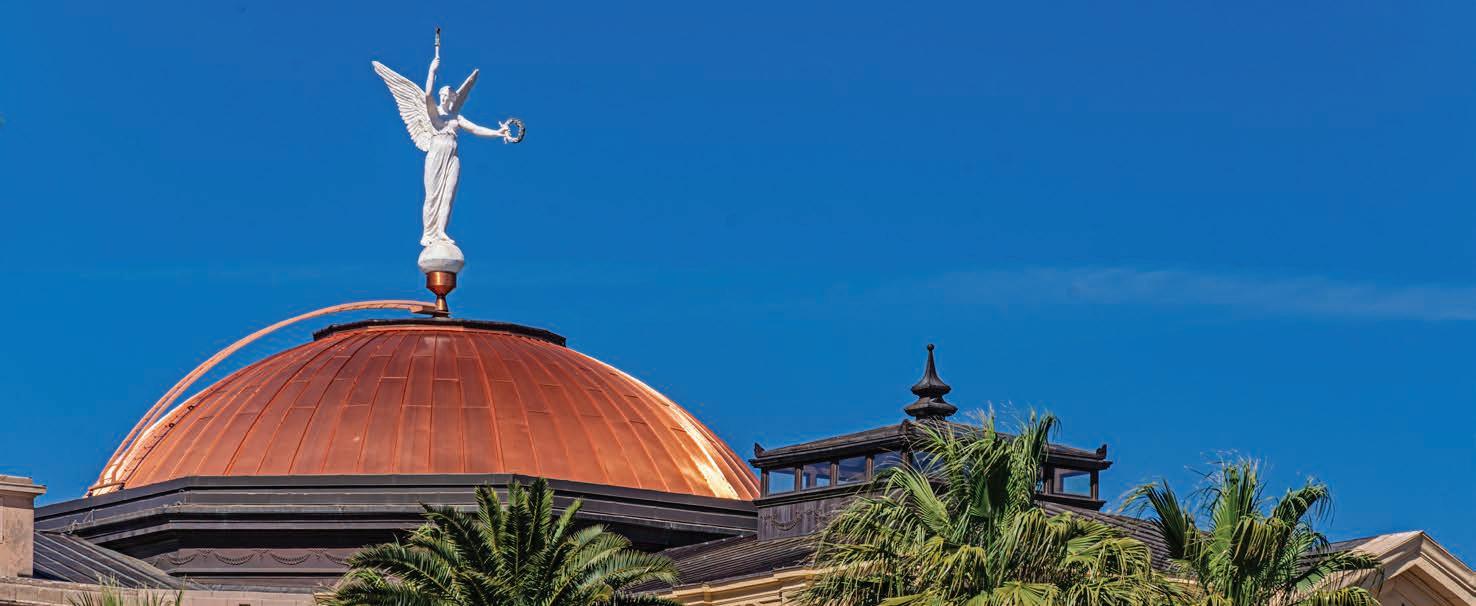
When it comes to public policy, efforts by the Arizona Technology Council are continuous as the responsibility of promoting and protecting the state’s technology community never stops.
The efforts are especially worth it when the successes can be tallied at the end of the legislative session of the Arizona Capitol.
Case in point are noteworthy actions from the recently completed session. Making it of cial are endorsements from Gov. Katie Hobbs that:
• Establish the Arizona Of ce of Defense Innovation within the Arizona Commerce Authority, which is charged with encouraging partnerships and driving innovation for defense technologies and leveraging assets to attract federal and private defense investments.
• With $2 million, launch the Advanced Air Mobility Fund to build vertiports as hubs for takeoffs and landings, as well as to buy advanced air mobility vehicles capable of carrying passengers or cargo for testing and demonstration purposes.
• Earmark $1 million to fund Department of Education training grants in its computer science professional development program, bringing Arizona one step closer to ensuring every student has the opportunity take a computer science course before graduating. One course in high school potentially boosts wages by 8% for all students, regardless of career path.
A “success” of another kind for Arizona’s technology industry actually occurred with Hobbs’ veto of legislation she deemed not supporting the state’s renewable energy efforts. In a letter to House Speaker Steve Montenegro, she wrote, “Bills like this one that seek to disincentivize, deprioritize or otherwise limit new renewable energy projects directly threaten Arizona’s new energy workforce growth and the associated potential for lowered energy bills while at the same time putting our grid reliability at risk.”
Efforts happening year-round are part of the responsibility of the Council’s Public Policy Committee, whose mission is to ensure Arizona’s competitiveness to accelerate technology-related policy and legislation. The results positively affect the growth and development of a vibrant technology state.
Open to employees of member companies, the committee focuses
on issues and initiatives that affect the growth and development of the technology industry. There actually are four targeted areas for the body: technology commercialization and development, workforce development, supply-chain development, and capital formation.
The committee works with legislators, elected of cials and policy makers at all levels of government to educate them on the value and promise of the technology industry. That means members can be found routinely walking the halls of the Capitol to speak with of cials and their staff.
Separately, the Council’s Political Action Committee (PAC) supports protechnology candidates for state and local of ces after thoroughly vetting them to ensure their priorities promote a thriving technology ecosystem in Arizona and improve the business climate for tech-based companies.
Because leaders at the state, county and local government levels make decisions impacting the technology industry and businesses while in uencing the economic vitality of communities, it is critical for companies to have a method like the PAC to support candidates and elected of cials who understand the impact of their decisions on the ecosystem.
To decide on recommendations, the Council and the PAC solicit information from candidates and conduct comprehensive interviews. Also, incumbents’ voting records are reviewed. The PAC then determines which candidates receive the Council’s election endorsements by comparing screenings and voting records to the Council’spolicy positions and guiding principles as stated in its Public Policy Guides published biennially.
Working behind the scenes to support and advise on strategies by the Council and its committees is Dianne McCallister of the lobbying rm Public Policy Partners.
It truly is a team effort when it comes to supporting Arizona’s tech ecosystem.
To learn more, visit aztechcouncil.org/public-policy for Public Policy + Advocacy, aztechcouncil.org/committees/public-policycommittee for Public Policy Committee and aztechcouncil.org/aztc-pac for Political Action Committee.
For many young people, considering whether to attend college is as big as the decision-making usually gets. And they often do it alone.
But for a group of youths no older than 18, they upped the ante by leading discussions that ultimately could impact the entire state.
More speci cally, several Chief Science Of cers, a program of SciTech Institute, served as moderators of conversations among nearly 50 other young people on what to consider when siting locations for nuclear waste storage.
To do this, SciTech Institute worked with 3CAZ — short for Community, Capacity and Collaboration in Arizona — to host two forums for high school students from across the Phoenix metro area. The Institute is a collaborative initiative of the Arizona Technology Council and Arizona Commerce Authority.
The meetings were part of 3CAZ’s larger effort to gather the public’s perspectives on nuclear waste management in the state. The goal is to inform the U.S. Department of Energy through a fair and community-driven process on where to build storage facilities, although currently there are no plans to site such facilities.
Still, the forums speci cally for younger people offered the opportunity for the CSOs to draw input from their peers on topics that could impact their generation and others that follow in Arizona. Acting as moderators also let them gauge their own growth in SciTech’s CSO program designed to let students in 6th through 12th grades serve as science, technology, engineering and math (STEM) leaders and ambassadors in their schools and communities.
For the forums, the moderators guided others in their groups through various activities to weigh priorities generated by the 3CAZ team in earlier consultations with communities throughout Arizona, nuclear waste experts and other stakeholders. For example, environment ranked the highest as an overall category of priorities established at the forums, followed by transparency and facility monitoring and security.
Reaching such a conclusion by young people might not have been possible previously without the growth offered in the CSO program.
“Being a Chief Science Of cer with SciTech Institute gave me the con dence and communication skills to lead thoughtful conversations,” says CSO Marek, a 10th grader
in Mesa. “The citizen forum on nuclear energy management was my rst time talking in-depth about nuclear energy, and I was surprised by how many layers there are to managing nuclear waste. Science, safety, ethics and equity all play a role. Most importantly, I learned that I’m capable of creating space for others to be heard, even on tough topics. That’s something I’ll carry with me beyond this project.”
Another student credited the forum with deepening his own thought processes and piquing his interest in applying to become part of the CSO program.
“I learned how important it is to ask not just ‘What should we do?’ but ‘Who does it affect?’ and ‘Who gets to decide?’” says Pranav V., a 12th grader in Phoenix. “Personally, I found out that I do well in settings where I can
listen and lead at the same time. It made me feel like a real part of something that matters.”
Jeremy Babendure, SciTech Institute’s executive director, noted why opportunities like the 3CAZ forum both bene t from and are bene cial for Arizona CSO leadership.
“By moderating complex conversations about nuclear waste storage, our Chief Science Of cers demonstrated not only a deep understanding of STEM topics but also the skill to lead their peers through dif cult discussions,” he says. “Their ability to connect science with community values is exactly why the CSO program exists: to prepare students to be thoughtful, inclusive decision-makers in our ever-evolving world.”
To learn more about the CSO International program, visit chiefscienceof cers.org
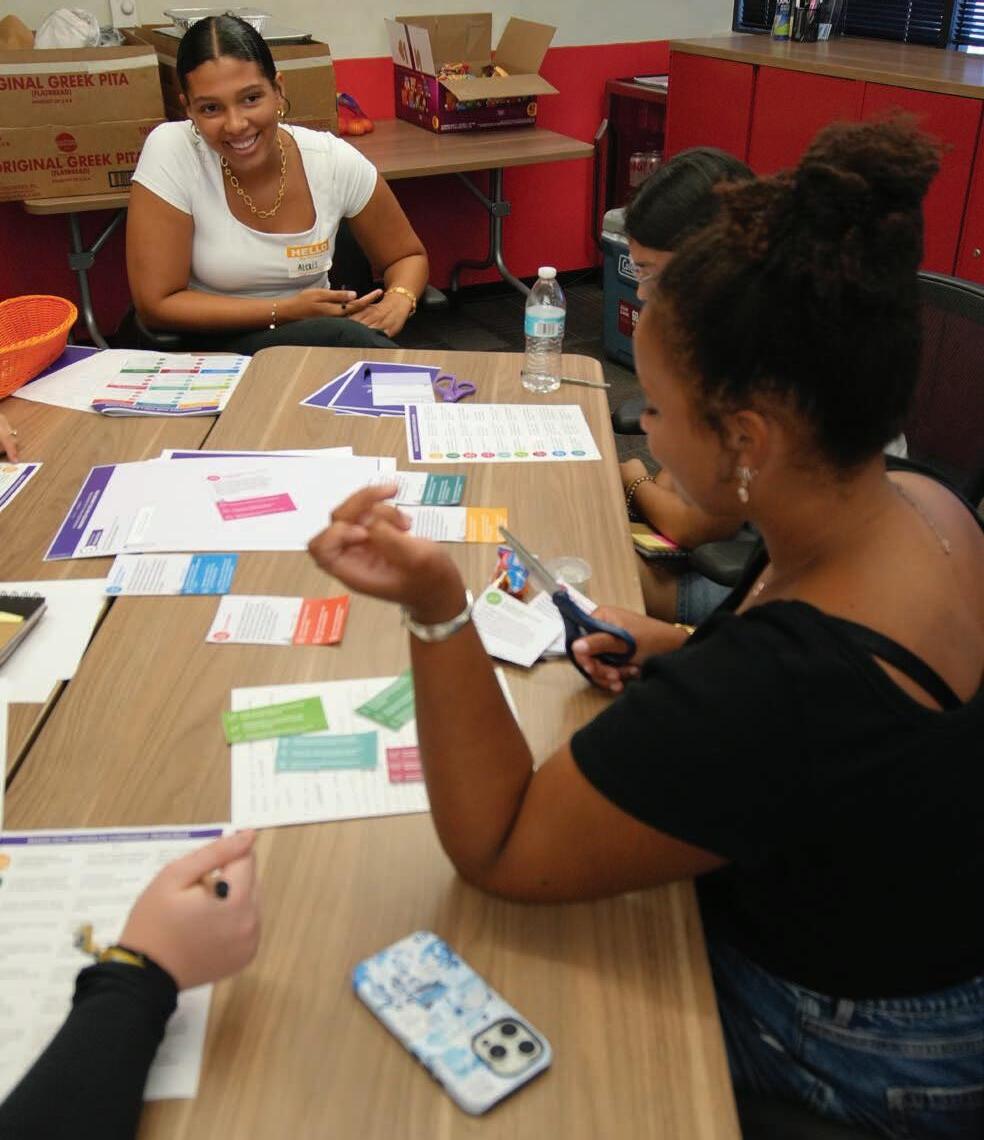
Few would dispute that technology is constantly evolving. Capturing the changes would be a daunting task for any historian trying to keep track of developments in order to relay the highlights to others.
But people interested in the progress of Arizona’s tech scene have it a little easier. They have been keeping tabs on what’s new since spring 2018 by clicking on the blog postings available to everyone on the Arizona Technology Council’s website.
What began with the posting titled “Effective Sales Presentation –The 18 Minute Rule” has turned into a living document that numbered 296 pages by early July.
For example, with all the talk about semiconductor manufacturing, ever wonder how the equipment needed to help produce those tiny wonders makes it to the other side of the globe? Check out a recent blog for a behind-the-scenes look at what Crating Technology of Phoenix does to make it happen.
In another post, Arizona State University shared how its collaboration with University of Wisconsin-Madison led to development of Wild re Awareness and Risk Management, or WARM, a re-detecting and risk-mitigating system designed to boost the effectiveness of re sensors while adjusting electric power grid operation.
Any Council member can submit guest posts, news and press releases for placement on the blog, explains Leslie Marquez, the
Council’s director of marketing and communications. “We post to the blog almost daily,” she says. “It’s a great extension of members’ existing marketing efforts.”
News posts include local and even international developments. For example, readers were able to learn why Time recently named Taiwan Semiconductor Manufacturing Company to the magazine’s list of 100 Most In uential Companies of 2025.
In an era when time is precious and fewer people subscribe to publications or comb the internet for news that interests them, the blog offers a one-stop destination to get what’s new in Arizona’s tech ecosystem. In particular, Marquez says, the blog offers Council member news, clean energy news and Council member-submitted thought leadership and subject-matter expertise.
To make it easier to get caught up, the Council also generates month-end Member News and Clean Energy News round-up blogs so readers can view all the news posted that month. This content is one of the reasons that last year the Council’s website averaged 16,409 new users monthly.
Links to the blog posts also are shared in the month-end TechTalk e-newsletter.
To view the blog posts, visit www.aztechcouncil.org/blog

The two newest members of the Arizona Technology Council’s board of directors bring expertise in global payment networks and technology, as well as information technology talent development.
Cheryl Eckardt, vice president of Global Network Service Technology at American Express, and Craig Jackman, founder and president of Paragon IT Professionals, were unanimously elected to three-year terms at recent quarterly Council board meetings.
Eckardt is responsible for the technology delivery of the American Express Payments Network, a high-performing, secure set of capabilities that processes more than 40 million global nancial transactions every day.
She previously was vice president of Finance Technology, where she partnered with the chief product owners to accelerate nance
platform modernization while delivering new business capabilities focused on regulatory compliance and advanced analytics. Eckardt also held leadership responsibilities in Global Risk and Compliance, Global Banking Technology, and the Colleague Experience Group.
Jackman has grown Paragon into a national rm with a full-time team of 25 and a contract services team of more than 200 consultants.
The company offers contract and direct-hire IT staf ng, as well as a project services division.
While Paragon’s core markets have historically been in Iowa, Nebraska and Minnesota, Jackman expanded operations into Arizona in 2019. Paragon has established a strong local presence as it continues to grow its Arizona market initiative with a dedicated team supporting technology clients across the state.

Cepand Alizadeh has joined the staff of the Arizona Technology Council as its rst government relations specialist to help ensure the state’s energy ecosystem remains innovative, sustainable and responsive to the increasing demands of residents and businesses.
Alizadeh is responsible for connecting with policymakers, community leaders and industry stakeholders to advance policy solutions that support clean and renewable energy technologies. He has a strong background in legislative policy, constituent relations and advocacy.
Most recently, he served as a council aide and policy advisor at the Tempe City Council, where he focused on municipal strategy and community outreach. He holds a Juris Doctor earned at the Sandra Day O’Connor College of Law at Arizona State University and a bachelor’s degree in foreign affairs and Middle Eastern studies from the University of Virginia.
“Cepand’s legal and policy background paired with his passion for sustainability and innovation make him ideal to support our clean energy priorities across Arizona,” says Steven G. Zylstra, president and CEO of the Council and SciTech Institute.
“As more technology companies establish operations in our state, the demand for renewable energy technologies has grown,” says Alizadeh. “By working together in this endeavor, we can ensure a healthy supply of diverse energy solutions that meet the needs of Arizona residents and businesses.”
Steven G. Zylstra, president and CEO of the Council and SciTech Institute, has been appointed by Gov. Katie Hobbs to serve on the state’s inaugural Arti cial Intelligence Steering Committee.
The committee brings together leaders and experts from across sectors to develop a statewide policy framework and governance strategy for the use of AI. The committee will guide the state’s efforts to harness AI for public good while ensuring responsible innovation and data privacy.
With decades of experience advancing public-private partnerships, Zylstra is a recognized voice on the ethical deployment of emerging technologies,
including arti cial intelligence, across industry and government.
Committee members also include workforce and education leaders, state and local government representatives, public interest technologists and civil rights advocates, and private sector AI and data ethics experts.
The AI initiative builds on Hobbs’ broader agenda to modernize government; support emerging technologies; and ensure Arizona remains competitive, innovative and future-ready. The committee held its rst meeting in May and is expected to release initial recommendations by spring 2026.
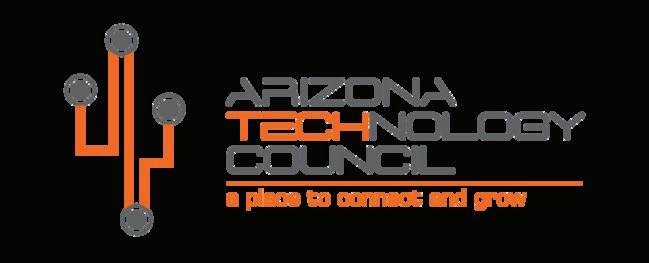

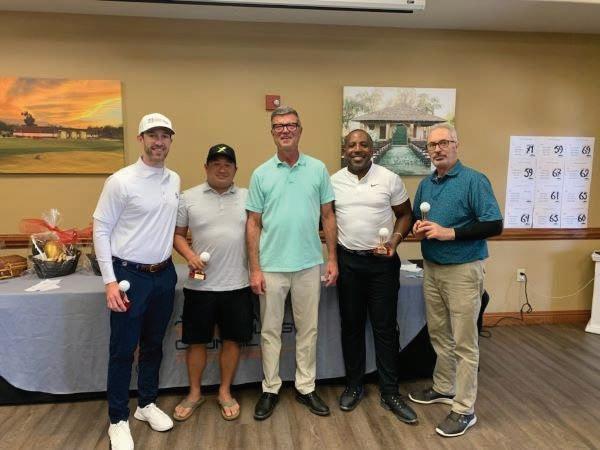










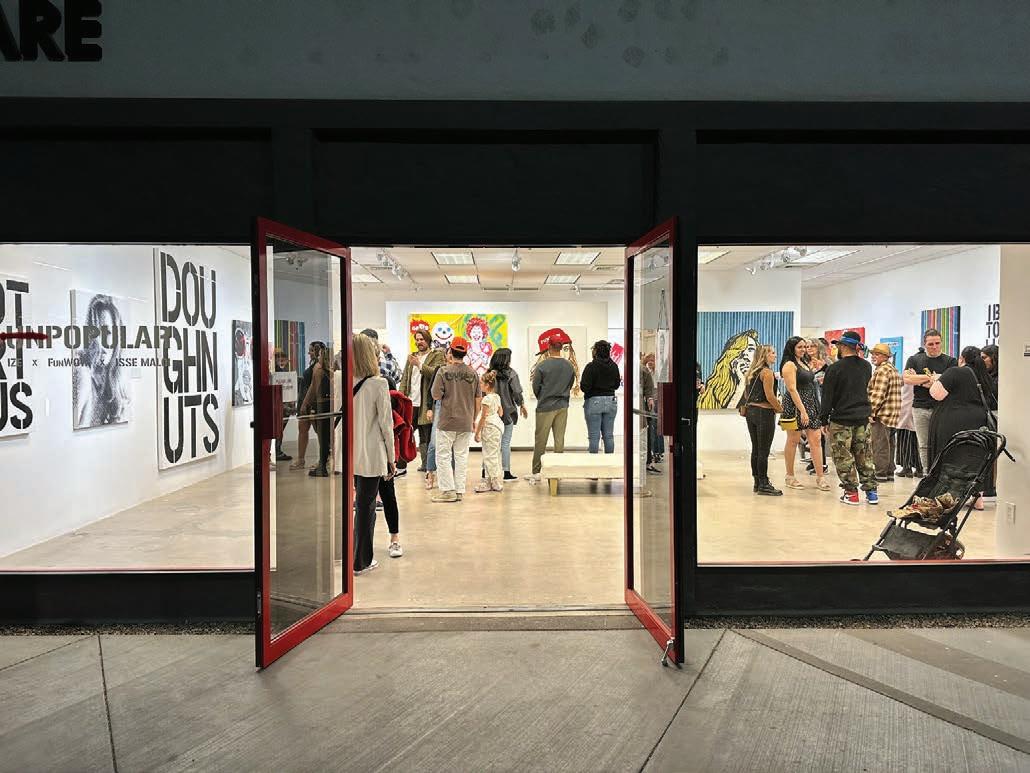
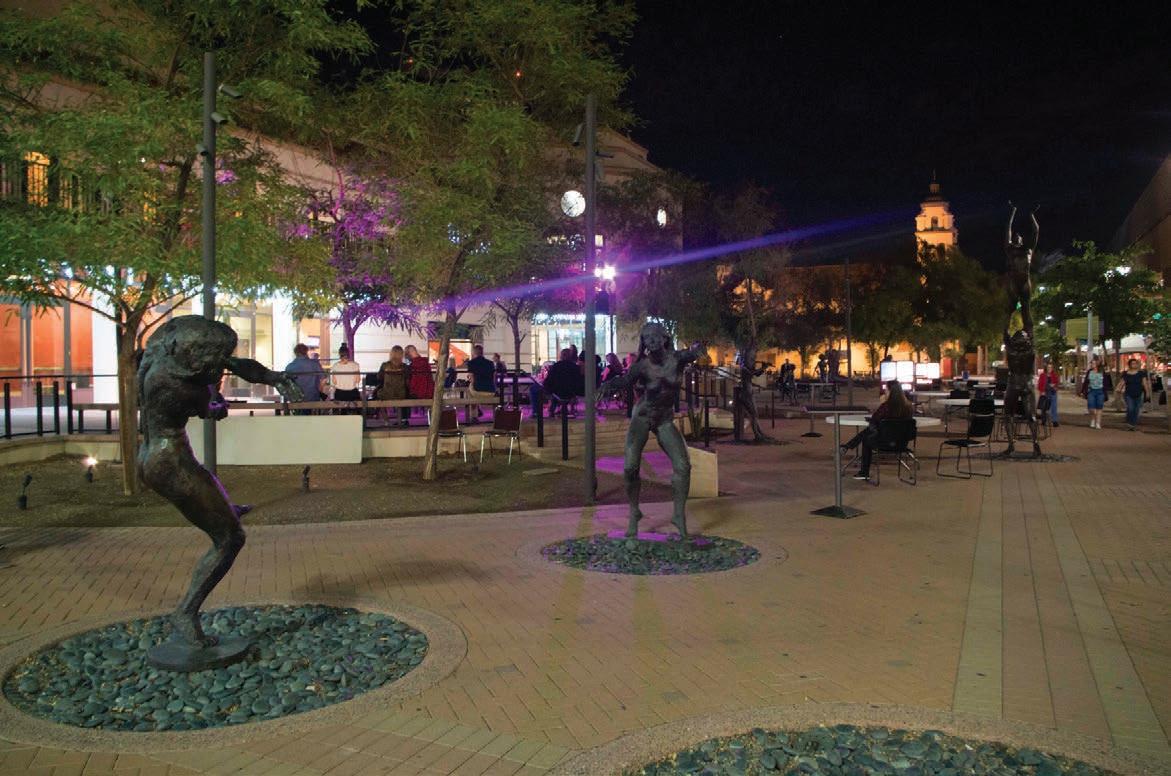




by Mike Hunter
Data from the most recent study on this economic sector released on March 25, 2024, show arts and cultural industries hit an all-time high in 2022, contributing 4.3% of gross domestic product, or $1.1 trillion, to the U.S. economy. Arizona’s arts & culture sector added a staggering $14.2 billion in value to the state’s economy, a 16.6% increase over 2021!
These ndings and more come from the Arts and Cultural Production Satellite Account (ACPSA), a product of the National Endowment for the Arts and the Bureau of Economic Analysis that tracks the annual economic value of arts and cultural production from 35 industries — including both commercial and nonpro t entities. A national summary report and an accompanying interactive graphic are available on the NEA’s website, along with state-level estimates.
In 2022, Arizona ranked 17th among all states in ACPSA value added and 6th among all states in ACPSA value-added growth. Since 2021, ACPSA value added has grown 16.2% in Arizona, compared with an increase of 7.8% for the United States.
In 2022, Arizona ranked 20th among all states in ACPSA employment and 47th among all states in ACPSA employment growth. Since 2021, ACPSA employment has decreased 0.9% in Arizona, compared with an increase of 6.4% for the United States.

The overall arts economy grew by 4.8% in in ation-adjusted dollars from 2021 to 2022, a rate increase far surpassing that for the entire U.S. economy during the same time period. Since the pre-pandemic year of 2019, arts and cultural industries have surged by 13.6%. By contrast, the U.S. economy grew by 5.5% over the same period.
The top ve industries by total value added to the U.S. economy in 2022 were web publishing and streaming, broadcasting, government services (including public schools), publishing, and motion picture and video industries. The largest arts and cultural industry in the U.S., web publishing and streaming services, grew 40.9% in value added to GDP since 2019. Yet, from 2021 to 2022, this industry declined for the rst time in recent history (by 1.4%).
In terms of percent growth in value added, in 2022, 25 out of 35 arts industries posted amounts exceeding 2019 levels, including agents and managers, sound recording, computer systems design, web publishing and streaming, and interior design services.
In Business Magazine has asked several of the Valley’s arts and cultural organizations to be included in this guide of venues, performing arts organizations, museums and attractions guide to identify just a handful of the groups who seek corporate support and want to create more awareness about their offerings to Valley residents and visitors. We hope our readers will support these great organizations and look at ways that they can attend, donate and engage in the arts right here in the Greater Phoenix area.
Arizona Opera Center
Since its inaugural year, Arizona Opera has produced more than 200 fully staged operas and concerts. The company’s artistic history is rich with a blend of opera’s traditional repertoire featuring baroque, bel canto and verismo works; turn-of-the-century masterpieces; operettas; and American operas. Arizona Opera has also presented Wagner’s complete “Ring Cycle” twice, a feat that has been accomplished in North America by only four other companies.
1636 N. Central Ave., Phoenix, AZ 85004 (602) 266-7464 • azopera.org
Arizona Theatre Company
The Arizona Theatre Company doesn’t just stage productions … it creates cultural experiences that resonate far beyond the curtain. As a vibrant nonprofit since 1966 and the Official State Theatre of Arizona, it is a hub where creativity thrives, and art takes center stage. Tempe Center for the Arts
700 W. Rio Salado Pkwy., Tempe, AZ 85281 (833) 282-7328 • atc.org
Ballet Arizona
Ballet Arizona is the Southwest’s premier nonprofit ballet institution, dedicated to educating, creating and performing remarkable classical and contemporary ballet. Through unparalleled performances showcasing mastery, elegance and excitement, Ballet Arizona provides guests an occasion the whole family is sure to remember.
2835 E. Washington St., Phoenix, AZ 85034 (602) 381-1096 • balletaz.org
The Black Theatre Troupe
(Helen K. Mason Performing Arts Center)
The Black Theatre Troupe, Inc. has been providing training, employment and performance opportunities for multiethnic and underserved artists since 1970 and acts to make significant contributions toward fostering the arts, specifically theater, within the State of Arizona. It operates to enhance the cultural and artistic awareness of the community by providing productions that illuminate the African American experience and culture. Its purpose and mission are to educate, enlighten and entertain a diverse, multicultural audience by using local, regional and national talent with the emphasis on providing exposure to black culture and ideology. 1333 E. Washington St., Phoenix, AZ 85034 (602) 258-8128 • blacktheatretroupe.org
Arizona Commemorative Air Force Museum
At the only combat aviation museum in Phoenix, visitors will take an edu-venture through history and learn how aircraft evolved as a vital partner to ground and sea operations from WWI to present. It’s an opportunity to get up close and personal with history. Friendly docents are the keepers of nostalgic, inspirational stories and are eager to answer any questions or lead a tour through the collection of artifacts and exhibits.
2017 N. Greenfield Rd., Mesa, AZ 85215 (480) 924-1940 • azcaf.org
Herberger Theater Center
Built in 1989 to support and foster the growth of performing arts in Phoenix as a performance venue and arts incubator, the Herberger Theater Center actively contributes to the cultural and educational development of the Valley. In addition to hosting resident companies and the exceptional work they do, the Center creates festivals that celebrate the arts; holds gallery shows and special events; and, in the face of a once-in-a century pandemic, even built a new outdoor stage to meet the moment.
222 E. Monroe St., Phoenix, AZ 85004 (602) 252-8497 • herbergertheater.org
Mesa Arts Center
The Mesa Arts Center is a performing and visual arts complex in downtown Mesa. At more than 210,000 square feet, the $95-million facility, completed in 2005, is the largest comprehensive arts campus in the state. The programs are hosted in four buildings on the Mesa Arts Center campus. This includes the four theaters, the Mesa Contemporary Arts Museum and 14 art studios.
One E. Main St., Mesa, AZ 85201 (480) 644-6500 • mesaartscenter.com
The Phoenix Theatre Company
The Phoenix Theatre Company, originally founded as the Phoenix Players in 1920, is the oldest arts organization in Arizona and remains one of the oldest operating arts organizations in the country.
The Phoenix Theatre Company has launched stars in the industry, developed young audiences, introduced emerging playwrights and composers, created a space for alternative and experimental theatre and hosted world premieres. Most importantly, it remains at the center of an active arts complex serving its audiences by creating dynamic, professional productions while following its mission of educating and elevating the growing Phoenix artistic and cultural community.
1825 N. Central Ave., Phoenix, AZ 85004 (602) 254–2151 • phoenixtheatre.com
Scottsdale Center for the Performing Arts
One of the premier performing arts halls in the western United States, Scottsdale Center for the Performing Arts showcases a diverse season of music, dance, theatre, comedy and film from around the world. Each year, the Center presents hundreds of events that entertain and inspire — from live performances and educational programs to community celebrations and major festivals.
7380 E. Second St., Scottsdale, AZ 85251 (480) 499-8587 • scottsdaleperformingarts.org
Arizona Heritage Center at Papago Park
The Arizona Historical Society is proud to serve as the steward of Arizona’s history. Its collections broadly represent Arizona history that offers a oneof-a-kind resource for Arizona history. Its artifact and manuscript holdings offer unique opportunities for public programming, educational outreach and exhibitions, as well as academic and communitybased research. AHS collections provide premier resources for recounting Arizona’s past, and they are invaluable tools for promoting public understanding of contemporary issues such as water availability, immigration, free trade, mining, and urban development and revitalization.
1300 N. College Ave., Tempe, AZ 85288 (480) 929-0292 • arizonahistoricalsociety.org

Tempe Center for the Arts is a vibrant part of the larger Tempe Arts + Culture Division. The iconic TCA facility serves as a cultural gem and the crown jewel of the city’s vibrant performing arts community. More than 200 provocative and inspiring programs are produced/hosted each year. Award-winning performances by national, regional and local dancers, musicians, educators, actors and more give voice to a wide variety of artistic expression and provide meaningful engagement for all audiences. Located on the edge of Tempe Town Lake, the center is home to The Arizona Theatre Company, seven select Resident Companies and a vibrant free art gallery.
700 W. Rio Salado Pkwy., Tempe, AZ 85281 (480) 350-2822 • tempecenterforthearts.com
TheaterWorks of Peoria
The 2024-2025 season marks the 39th season for TheaterWorks, which produces full seasons of theater (Main Stage series), youth theater (Youth Works), youth education camps and classes (Theater Alive and SummerWorks) and more. TheaterWorks welcomes thousands of school-aged youth to field trip performances, hundreds of young people to its YouthWorks Academy classes and camps, more than a hundred young people to its stages, and draws more families than ever before to the programming offered by TheaterWorks.
10580 N. 83rd Drive, Peoria, AZ 85345 (623) 815-7930 • theaterworks.org
Valley Youth Theatre
Recognized for its professional-quality performances and exceptional teaching staff, Valley Youth Theatre has continuously impacted the vitality and diversity of the arts in Phoenix. While some VYT alumni go on to become professional theatre, television and film actors, many reach their full potential in other professions to become police officers, professors, attorneys, chefs, parents and community leaders.
525 N. First St., Phoenix, AZ 85004 (602) 253-8188 • vyt.com
Arizona Museum of Natural History
Nestled in the heart of Downtown Mesa, the 80,000-square-foot Arizona Museum of Natural History offers plenty to see, learn and explore for dino enthusiasts and historians of all ages. Admire its collection of nearly 60,000 objects, snap a selfie with a T-Rex, pan for gold, discover the origins of the galaxy, and take a stroll through a mock village of our ancestral Sonoran Desert people at this popular Mesa attraction.
53 N. Macdonald, Mesa, AZ 85201 (480) 644-2230 • arizonamuseumofnaturalhistory.org
Arizona Science Center
When it first opened in downtown Phoenix in 1984, Arizona Science Center was a small space on the map, occupying a modest 10,000-square-foot storefront. A pilot science center by the Junior League of Arizona, the Center (then called Arizona Museum of Science and Technology) quickly proved its value, however, welcoming more than 87,000 visitors its first year. With its unique ability to inspire, educate and engage curious minds through science, Arizona Science Center quickly grew in popularity and created the need for a larger space. So, in 1997, it moved into a 120,000-square-foot building that was designed by award-winning architect Antoine Predock. Today, the Center still occupies this distinct building within Heritage and Science Square and has added an additional 18,000 square feet with the opening of CREATE at Arizona Science Center®.
600 E. Washington St., Phoenix, AZ 85004 (602) 716-2000 • azscience.org
ASU Art Museum
Arizona State University Art Museum centers art and artists in the service of community well-being and social good. Designed by Antoine Predock and opened in 1989, the Nelson Fine Arts Center facility is located on ASU’s Tempe campus with three floors of year-round exhibitions that rotate seasonally and the award-winning museum store.
51 E. 10th St., Tempe, AZ 85281 (480) 965-2787 • asuartmuseum.org
Children’s Museum of Phoenix
One of the top children’s museums in the nation, the Children’s Museum of Phoenix is a wondrous place of imagination, inspiration, creativity and just plain fun! Designed for children ages birth to 10, this is not your typical Museum … visitors are actively welcomed to touch EVERYTHING! And with more than 48,000 square feet of space, there’s plenty to touch. The Museum offers more than 300 play experiences, spread throughout three floors in the magnificent and historic Monroe School Building.
215 N. 7th St., Phoenix, AZ 85034 (602) 253-0501 • childrensmuseumofphoenix.org
Hall of Flame Museum of Firefighting
George F. Getz Jr. founded the Hall of Flame in 1961. He organized the National Historical Fire Foundation as a 501(c)(3) nonprofit organization to promote the programs of a museum, which he named the Hall of Flame. Getz began to collect fire apparatus after the Christmas 1955 present of a 1924 American LaFrance fire engine from his wife, Olive Atwater Getz. 6101 E. Van Buren St., Phoenix, AZ 85008 (602) 275-3473 • hallofflame.org
George Washington Carver Museum and Cultural Center
The George Washington Carver Museum and Cultural Center is a premier cultural institution that is the steward of the African American experience in Phoenix. The museum honors African American Heritage and Arts & Culture. The George Washington Carver Museum and Cultural Center established by the Phoenix Monarchs Alumni Association of Arizona in 1986 is committed to moving forward with the vision of creating a community gathering place for cultural learning. It was approved March 1, 2017 as an Historic Landmark.
415 E. Grant St., Phoenix, AZ 85004 (602) 254-7516 • gwcmccaz.org
Since its founding in 1929, the Heard Museum, a private nonprofit organization, has grown in size and stature to become recognized internationally for the quality of its collections, world-class exhibitions, educational programming and unmatched festivals. It consists of 12 galleries featuring American Indian art and exhibitions, an outdoor sculpture gallery, a world-class museum shop and an outdoor café.
2301 N. Central Ave., Phoenix, AZ 85004 (602) 252-8840 • heard.org
i.d.e.a. Museum
The i.d.e.a. Museum — which is owned by the City of Mesa and supported by the i.d.e.a. Museum Foundation — offers hands-on activities and art exhibitions for kids of all ages. Programs are developed not only for children but also — most importantly — for the whole family. The museum inspires visitors to experience their world differently. Therefore, in addition to art, creativity and imagination, it focuses on supporting early learning, nurturing creative thinking and engaging families in quality experiences.
150 W. Pepper Pl., Mesa, AZ 85201 (480) 644-idea (4332) • ideamuseum.org
Musical Instrument Museum (MIM)
MIM has a collection of more than 7,500 instruments from more than 200 world countries and territories. The galleries reflect the rich diversity and history of many world cultures. But music and instruments also show us what we have in common — a thought powerfully expressed in the MIM’s motto: Music is the language of the soul.
4725 E. Mayo Blvd., Phoenix, AZ 85050 (480) 478-6000 • mim.org
Penske Racing Museum
The Penske Racing Museum showcases an amazing collection of cars, trophies and racing memorabilia chronicling the career of one of the most successful dynasties in all of sports. Penske Racing has more than 50 years of racing experience and more than 600 major race wins highlighted by 20 Indianapolis 500-mile race victories. On display in the museum are cars detailing the diversity of Penske Racing, including a 1974 Penske PC1 Ford Cosworth Formula 1 car driven by Mark Donohue. Additionally, a number of Indianapolis 500-mile race winners are on display including the 1991 Penske PC21 Chevy driven by Rick Mears to his record tying fourth Indy 500 win.
7191 E. Chauncey Ln., Phoenix, AZ 85054 (480) 538-4444 penskeautomall.com/penske-racing-museum
Phoenix Art Museum
Phoenix Art Museum has provided access to visual arts and educational programs in Arizona for more than 60 years and is the largest art museum in the Southwestern United States. In addition to an annual calendar of exhibitions, Phoenix Art Museum’s permanent collection galleries are drawn from more than 19,000 works of American, Asian, European, Latin American, Western American, modern and contemporary art, and fashion design.
1625 N. Central Ave., Phoenix, AZ 85004 (602) 257-1880 • phxart.org
SMoCA
Scottsdale Museum of Contemporary Art
SMoCA is a museum dedicated to contemporary art, architecture and design. Far more than just an arts and culture destination, Scottsdale Arts is a hub for creativity and innovation that welcomes all.
7374 E. Second St., Scottsdale, AZ 85251 (480) 874-4666 • smoca.org
S’edav Va’aki Museum (formerly Pueblo Grande Museum)
The S’edav Va’aki Museum officially reopened to the public on October 17th, 2024, with a refreshed lobby and two newly appointed exhibit galleries. Along with these changes, the reopening also features the implementation of the museum’s new hours of operation and new admission rates.
4619 E. Washington St., Phoenix, AZ 85034 (602) 495-0900 phoenix.gov/parks/arts-culture-history/sedav-vaaki
Shemer Art Center
The Shemer Art Center is a true “home for the arts.” It is also one of the City of Phoenix’s Points of Pride. In 1992, the Phoenix Pride Commission asked Phoenix residents to name places that make Phoenix unique. More than 10,000 postcards, listing approximately 150 locations, were received during the initial campaign. From the 40 sites receiving the most votes, the first 25 Points of Pride, including the Shemer Art Center, were selected.
5005 E. Camelback Rd., Phoenix, AZ 85018 (602) 262-4727 • shemerartcenter.org
Western Spirit:
Scottsdale’s Museum of the West
Western Spirit: Scottsdale’s Museum of the West is a premier cultural institution situated in Old Town Scottsdale. Established in January 2015, the museum resides on the historic grounds of the Loloma Transit Station (N. Marshall Way and E. First St.). With a sprawling two-story layout encompassing 43,000 square feet, the museum showcases the art, culture and rich history spanning 19 states in the American West, Western Canada and Mexico. Former Scottsdale mayor Herb Drinkwater (1936–97), who served from 1980 to 1996, envisioned the museum, which became a reality through the City of Scottsdale’s ownership and the dedicated operation by The Scottsdale Museum of the West, a nonprofit organization established in 2007.
3830 N. Marshall Way, Scottsdale, AZ 85251 (480) 686-9539 • westernspirit.org
Taliesin West
Frank Lloyd Wright Foundation
Having purchased several hundred acres of land in the then rural foothills of northeast Scottsdale, Wright began to conceive of a desert utopia comprised of low-slung buildings designed to reflect the sweeping expansiveness of the desert. Always in favor of local materials, Wright would construct Taliesin West largely of “desert masonry”: local rock set in wooden forms and bound by a mixture of cement and desert sand.
12621 N. Frank Lloyd Wright Blvd. Scottsdale, AZ 85259 (888) 516-0811 • franklloydwright.org/taliesin-west

Recognized as the Of cial State Theatre, Arizona Theatre Company is the state’s leading professional regional theatre, producing high-caliber productions for nearly 60 years. With a steadfast commitment to artistic excellence, statewide accessibility and meaningful community engagement, ATC brings the transformative power of live storytelling to audiences in both Tucson and Metropolitan Phoenix. Audiences can expect a wide range of shows at ATC, from beloved classics to new and exciting plays and musicals. The company’s dedication to producing high-quality theatre is clear in every production. Each play is chosen to engage, entertain and inspire audiences.
Performing in Metropolitan Phoenix at Tempe Center for the Arts, ATC brings the best regional theatre to patrons, promising exceptional experiences for both locals and tourists.
The 2025/2026 season offers action-packed sequences, toe-tapping music and moments that will leave audiences rolling on the oor with
Organization Name: Arizona Theatre Company
Arts & Cultural Category: Theatre
Name& Position of Org Leader: Matt August, Kasser Family Artistic Director
No. of Years Leader has Been Onboard: 3
Number of employees: 75-100
Main Local Office/Address: 700 W. Rio Salado Parkway, Tempe, AZ 85281
Phone: (833) ATC-SEAT [(833) 282-7328]
Website/Tickets: atc.org
laughter. Adapted from Patrick Hamilton’s Gaslight, Deceived (10/25/2025–11/09/2025) opens the season with a tense psychological thriller that follows a young woman who struggles to decipher fact from ction within the walls of her own home. Next up, ATC audiences will be thrust into the adrenalinepumping world of Heist (1/10/2026–1/25/2026). Inspired by caper classics like Ocean’s Eleven, The Italian Job and The Sting, audiences can expect a delicious display of daring escapes, disguises and doublecrosses. Audiences looking to get into a new rhythm for 2026 will love Ain’t Misbehavin’ (2/21/2026–3/08/2026), an upbeat musical revue honoring the greatest hits of Fats Waller. The season continues with The Roommate (4/11/2026–4/26/2026), a fresh new Broadway comedy about two women navigating life as empty nesters. Finally, ATC will close the season with a hilarious twist on one of literature’s most iconic characters in Dracula: A Comedy of Terrors (5/23/2026–6/07/2025).
Average ticket price/costs? Starting at $33
Annual subscriptions? Yes
Top 3 events/attractions/seasonal performances: ATC’s 2025/2026 Season includes “Deceived,” “Heist,” “Ain’t Misbehavin’,” “The Roommate,” and “Dracula: A Comedy of Terrors”
Donations link: atc.org/donate

Arizona Opera’s 2025/26 season features three unforgettable productions in Phoenix and Tucson, each leaping from the page to the stage with beautiful music, riveting characters and drama, and everything you’d expect from the incredible world of opera. The season also features a recital in March from operatic sensation Jamie Barton, “Opera’s Nose-Studded Rock Star” (The New York Times).
This fall, the legendary masked vigilante, Zorro, makes a thrilling appearance in a new opera by Héctor Armienta, marking the production’s Arizona premiere. Follow the return of Diego de la Vega to his native pueblo in Los Angeles, encountering old ames and tyrannical rulers as he ghts to right the plight of the oppressed. Performed in both Spanish and English alongside Puccini-esque melodies with a Latin air, Zorro is guaranteed to be a “swashbuckling’ly good time” (Opera San José).
This winter, Puccini’s masterpiece, Madama Butterfly, returns to the stage with a story of hope, ultimate sacri ce and some of the most gorgeous melodies
Organization Name: Arizona Opera
Arts & Cultural Category: Opera
Name& Position of Org Leader: Brian DeMaris
No. of Years Leader has Been Onboard: Joined in June, 2025
Number of employees: 10–25
Main Local Office/Address: 1636 N. Central Ave., Phoenix, AZ 85004
Phone: (602) 266-7464 (Phoenix), (520) 293-4336 (Tucson)
in opera. Follow the young geisha Cio Cio San as she dreams of a life of love with Pinkerton, an American naval of cer. Betrayal and heartbreak cast their shadow, leading to an unforgettable climax. For generations, Madama Butterfly has captivated audiences and will once again in Arizona this winter.
In the spring, step into the magic of Rossini’s Cinderella (La Cenerentola), a delightful semi-staged production brimming with humor, charm, and enchanting melodies. Angelina — mistreated by her stepfather, Don Magni co, and his scheming daughters — dares to dream of a brighter future. With help from Prince Ramiro’s clever valet and a sparkling twist involving a pair of bracelets, Angelina must navigate royal intrigue to capture the prince’s heart. This vibrant retelling of the beloved fairytale promises laughter, romance and soaring arias to adore.
Information and tickets, including for Jamie Barton’s recitals, are available at azopera.org. Subscribe today to save off regular prices and more.
Website/Tickets: azopera.org
Average ticket price/costs? Varies – typically from $30 to $175 for Main Stage Productions
Annual subscriptions? Yes, available at azopera.org or by calling Patron Services at the phone numbers listed above
Top 3 events/attractions/seasonal performances: For 2025/26 Season: Zorro, Madama Butterfly, Cinderella (La Cenerentola)
Donations link: tickets.azopera.org/donate/contribute1


The Children’s Museum of Phoenix fosters a joy of learning through play. With exhibits and programs designed for children ages birth to 10, our mission is to engage the minds, muscles and imaginations of children and the grownups who care about them.
The Children’s Museum of Phoenix stands out in many unique ways — it’s not just a museum, it’s a joyful, imaginative play space designed to support learning through open-ended, hands-on play. Built around the principle that play is how young children learn, the Museum houses more than 300 interactive experiences across three oors in the historic Monroe School building in downtown Phoenix. Each of the Museum’s exhibits supports multiple developmental levels –— so a toddler and an older child can enjoy the same space in different ways. Here children can: scale The Climber, a three-story climbing structure encouraging safe perceived-risk play and gross motor skill development; navigate the Noodle Forest, a “forest” of pool noodles suspended from above, offering sensory immersion in a unique and engaging environment; role play in The
Organization Name: Children’s Museum of Phoenix
Arts & Cultural Category: Children’s Museum
Name& Position of Org Leader: Kate Wells, Chief Executive Officer
No. of Years Leader has Been Onboard: 12 years
Number of employees: 90
Main Local Office/Address: 215 N. 7th St., Phoenix, AZ 85034
Phone: (602) 648-2746
Market as children exercise their physical, cognitive and social skills while providing opportunities to engage in group play, measuring, weighing, reading and counting; and build and engineer in BlockMania!, to name just a few of the Museum’s exciting exhibits.
Whether you’re encouraging early childhood development, playing together with caregivers or seeking a safe inclusive space, the Children’s Museum of Phoenix offers something meaningful for everyone.
The Children’s Museum of Phoenix is located at 215 N. 7th Street in downtown Phoenix. Tickets are $19 per person. Members and children under the age of 1 are free. Tickets can be purchased onsite or online at ChildrensMuseumOfPhoenix.org. The Museum is open Tuesdays –Sundays and select holiday/school break Mondays, 9am – 4pm. During summer, the Museum is open 7 days a week from Memorial Day through Labor Day. The Children’s Museum of Phoenix is a 501(c)(3) nonpro t organization, EIN #86-0934323.
Website/Tickets: childrensmuseumofphoenix.org
Average ticket price/costs? $19 per person. Children under age 1 are free.
Annual subscriptions? Yes
Top 3 events/attractions/seasonal performances: Happy Noon Year, CARnival, Children’s Museum Gala
Donations link: 19875.blackbaudhosting.com/ 19875/Direct-Public-Giving





Every Great City Has a Great Symphony
Since 1947, the Phoenix Symphony has been one of Arizona’s most important cultural institutions, bringing the power of live music to stages, classrooms, hospitals and neighborhoods across the Valley. Performing both timeless classics and innovative new works, the Symphony calls Symphony Hall its home while reaching audiences throughout Greater Phoenix and beyond.
Backed by generous support from individuals, corporations and foundations, the Symphony’s world-class musicians do more than perform; they serve as ambassadors of music’s ability to inspire, unite and heal. At its core, the mission of the Phoenix Symphony is to provide extraordinary musical experiences that enrich the lives of people of all ages and backgrounds.
Learn more: www.phoenixsymphony.org/about-us
A Symphony in Transition and Transformation
This season marks an exciting moment in the Symphony’s evolution as it conducts an international search for its next Virginia G. Piper Music Director. The strong interest from acclaimed conductors re ects both the talent of our orchestra and the vitality of Arizona’s arts community. The next music director will inherit a rich legacy and help shape the Symphony’s bold future.
Symphony for All: Expanding Access to Music
The Phoenix Symphony is committed to ensuring that world-class music is accessible to everyone. Its Symphony for All initiatives remove barriers to attendance and are made possible through philanthropic support:
• KidTix: Free tickets for youth ages 5–17 with a paid adult (for select concerts)
Organization Name: The Phoenix Symphony
Arts & Cultural Category: Symphony / Live Music
Name& Position of Org Leader: Peter Kjome, President and CEO
No. of Years Leader has Been Onboard: 3 years
Number of employees: 109
Main Local Office/Address: One N. First St., Suite 200, Phoenix, AZ 85004
Phone: (602) 495-1999
• Military & Veterans Program
• Student & Senior Discounts
• Culture Pass: Free tickets through local libraries
These programs welcome thousands of new concertgoers each season. With continued support, the Symphony aims to expand this reach across Arizona.
Learn more: www.phoenixsymphony.org/symphony-for-all
Community Engagement & Education: Music with Purpose
The musicians of the Phoenix Symphony don’t just perform — they participate. As Arizona residents, they actively bring music into schools, shelters, libraries and community centers, using it as a tool for learning, healing and connection.
Education is a cornerstone of the Symphony’s mission. Each year, it reaches more than 100,000 students through in-school concerts and music programs. In addition, the Symphony’s Music and Wellness programs provide comfort and connection to adults in hospitals, Alzheimer’s care centers, hospice settings and individuals experiencing homelessness. Phoenix Symphony musicians travel more than 14,000 miles annually to share music’s impact across the state.
Learn more: www.phoenixsymphony.org/education-community
More Than a Concert: A Catalyst for Community
Whether in the concert hall, a classroom or a care facility, The Phoenix Symphony inspires. It is a cultural beacon, a community builder and a force for good. As the Symphony enters its next chapter, it invites all to be part of the journey — because in Phoenix, music is for all.
Learn more: www.phoenixsymphony.org
Website/Tickets: phoenixsymphony.org
Average ticket price/costs? $23 + and up Season Tickets? Yes
Top 3 events/attractions/seasonal performances: More than 100 performances a season: Concerts include Classics, Phoenix Pops, Films & Specials. Musicians perform in classrooms, shelters and hospitals.
Donations link: phoenixsymphony.org/donate

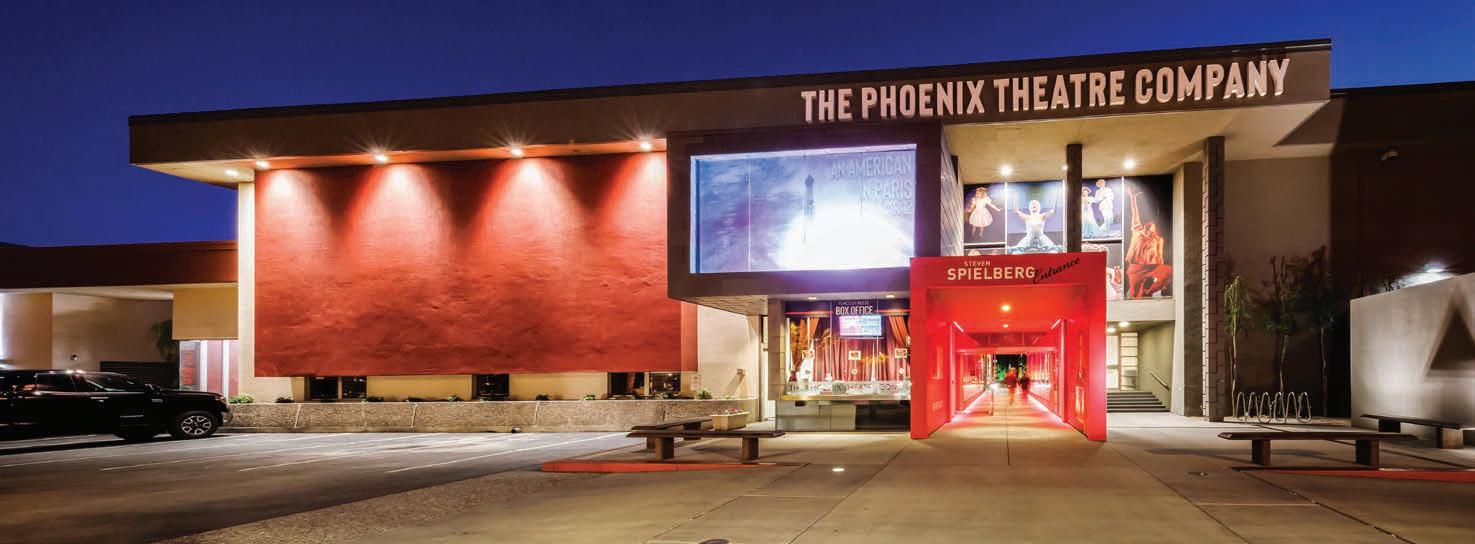
Welcome to the 106th season at The Phoenix Theatre Company, where unforgettable moments spark change, bold stories ignite conversation, and the power of human connection takes center stage. Founded in 1920, The Phoenix Theatre Company is Arizona’s rst arts organization and the largest professional regional theatre company in the state. With nearly 600 performances presented annually across multiple stages, it plays a vital role in the cultural fabric of the Valley and is a proud founding member of the Central Arts District.
This season celebrates courage, resilience and reinvention. From the world premiere of The Roads to Loch Lomond and the Arizona premieres of Come From Away and Ever After to beloved classics such as Hairspray and A Christmas Carol, the lineup features stories that move hearts and inspire hope. The season also includes two intimate biographical portraits, Looking Over the President’s Shoulder and Tenderly, The Rosemary Clooney Musical, along with powerful narratives about how the written word can shape lives in Dear Evan Hansen and Daddy Long Legs. Rounding out the season is the electrifying Million Dollar Quartet, an unforgettable night featuring four musical legends.
This year marks the opening of the brand-new Dr. Stacie J. and Richard J. Stephenson Theatre, a state-of-the-art venue designed to elevate every aspect of the theatrical experience. With expanded seating, enhanced acoustics,
Organization Name:
Arts & Cultural Category: Theater
Name& Position of Org Leader: Michael Barnard, Producing Artistic Director Vincent VanVleet, Executive Director
No. of Years Leader has Been Onboard: Barnard is at 27 yrs/seasons
VanVleet has 28 yrs/seasons
Number of employees: 535
upgraded lighting and sound technology, and a more intimate connection between the audience and the stage, this new space enables the company to produce musicals with greater scale, detail and ambition than ever before. The Stephenson Theatre represents a bold step forward in how stories are told, how they connect with audiences and how they shape the future of the arts.
From casting and costumes to set and technical designs, music and more, nearly every element seen and heard is developed in-house and seamlessly integrated into each production. The Phoenix Theatre Company is proud to be the top employer of artists in the State of Arizona, engaging more than 400 individuals annually. This includes professional actors, musicians and technicians, as well as essential support staff such as waiters, bartenders, house managers and administrative personnel. This holistic approach strengthens the local community and ensures an exceptional standard of quality, making every production a celebration of artistic collaboration and excellence.
Join The Phoenix Theatre Company in stepping into this exciting new chapter. Your seat is waiting.
How can corporate get donors involved?
We offer a range of giving opportunities tailored to corporate interests, from customized sponsorships to exclusive event packages and naming opportunities.
Main Local Office/Address: 1825 N. Central Ave., Phoenix, AZ 85004
Phone: (602) 254-2151
Website/Tickets: phoenixtheatre.com
Average ticket price/costs? $59+
Season Tickets? Yes
Top 3 events/attractions/seasonal performances: Disney’s Frozen, Come From Away, Ever After
Donations link: donate.phoenixtheatre.com/donate


Art on the Wild Side is a rotating art exhibit program at the Phoenix Zoo dedicated to inspiration, celebration and conservation through art. The Zoo currently hosts two galleries, the Savanna Gallery and the Wild Side Gallery. Both galleries provide our guests the opportunity to connect with the Zoo’s mission - To advance the stewardship and conservation of animals and their habitats while providing experiences that inspire people and motivate them to care for the natural world.

Now – September 28, 2025
Come and celebrate with the children and grandchildren of Zoo staff and volunteers, as we gain a unique perspective from those who love and know it best!

Now – August 24, 2025
This unique show highlights the creativity and passion of the Zoo community through art created by Zoo staff, volunteers and partners!
September 4, 2025 – January 25, 2026
The Zoo is proud to announce their first exhibit of comic book art and other forms of graphic illustration featuring each artist’s unique and bold interpretation of wildlife and the natural world.

January 29 – May 31, 2026
Thomas D. Mangelsen: A Life in the Wild Tour, features forty of Mangelsen’s most iconic images - personally selected by the artist and known as his “legacy photographs.”
Aimé, Guillaume, 38
Alizadeh, Cepand, 51
August, Matt, 58
Ayres, Greg, 14
Barnard, Michael, 63 Bell, Brandon, 14
Blanchard, Ken, 40
Bolen, Sam, 42
Brady, Chris, 28 Butler, Tyler, 40 Carter, Heather, 24
Clark, Donald R., 14
Collins, Christopher, 46
Dawes, Nina, 40 DeMaris, Brian, 59
Airedale Modine, 26
American Express, 51
American Red Cross, 67
Amkor Technology, 22
Arizona Commerce Authority, 2, 3, 9
Arizona Community Foundation, 41
Arizona Financial, 19
Arizona Opera, 59
Arizona Technology Council, 47
Arizona Theatre Company, 58
Artlink, 54
Aspirant Development, 18
Audi, 45
BioLab Holdings, Inc., 10
Blue Cross Blue Shield of Arizona, 24
Boeing, 28
Camelot Homes, 14
CBIZ, 36
Children’s Museum of Phoenix, 60, 61
Copper State Credit Union, 10
Delta Dental of Arizona, 14
ECM Technologies, 14
Edward Jones, 40
Empire Group of Companies, 18
Deneke, Sam, 28
Driggs, Ben, 28
Eckardt, Cheryl, 51
Gaspers, Mark, 28
Gilkeson, Gus, 35
Jackman, Craig, 51
Jacobs, Geoffrey, 18
Johnson, Jill Hawkins, 15
Kaplan, Jennifer, 66
Kjome, Peter, 62
Krumwiede, David, 18
Krupski, Brian, 15
Levos, Hanna, 10
Lorah, Emily, 10
Luthra, Poornima, 34
evolve PR & Marketing, 66
Ford Motor Company, 12
Gallagher & Kennedy, 38
General Dynamics Mission Systems, 28
George Oliver, 18
Goodwill of Central and Northern Arizona, 37
Goodyear, City of, 27
GrinGo, 15
Hadrian, 22
Harvard Investments, 18
Honeywell Aerospace, 28
HonorHealth, 25
JHJ Collective, 15
Jive, 8
Kiterocket, 23
Lasgidi Cafe,16
Lincoln Property Company, 18
National Bank of Arizona, 13
Next Level Steel, 14
Nox Group, 14
Optum, 5
Owl Labs, 45
PADT, 13
In each issue of In Business Magazine, we list both companies and indivuduals for quick reference. See the stories for links to more.
McCann, David, 22
Molloy, Cameron, 14
Natarelli, Joseph, 36
Nina Sharpe, 26
Odneal, Megan, 40
Orsak, John, 18
Pfeiffer, Véronique, 35
Power, Chris, 22
Roduenz, Kimberly, 26 Ross, Ryan, 24
Ryder, Kim, 17
Simpson, Fay, 40
Singpradith, Amy, 10 Smith, Amber, 20
Somers, Scott, 22
Thorburn, Erin, 43
Titcombe, Patience, 16
Tollefson, Richard, 44
VanVleet, Vincent, 63
Warner, Ashley, 40
Watson, Sandra, 9
Wells, Kate, 60
Whalen, R. Christopher, 35
Wilde, Trevor, 10
Wormald, Nick, 35
Wright, Geri, 58
Zylstra, Steven, 47
Paragon IT Professionals, 51
Phoenix Philanthropy Group, The, 44
Phoenix Symphony, The, 21, 62
Phoenix Theatre Company, The, 63 Phoenix Zoo, 64
Polestar Scottsdale, 69
Prisma Community Care, 11
ProTech Detailing, 7
Raytheon, 28
REDW Advisors & CPAs, 42
Rock View Recovery, 24
Roman Empire Agency, 10
Saint Urban, 46 SRP, 43
Stearns Bank, 8
Sunbelt Holdings, 7 Terracon, 14
Visit Mesa, 14 Wilde Wealth Management Group, 10, 14

Bold listings are advertisers supporting this issue of In Business Magazine

Jennifer Kaplan is the president and CEO of Evolve PR & Marketing, Arizona’s largest public relations firm.
A Phoenix native and ASU alumna, she leads a team of 25 publicists representing more than 100 clients across local and national markets. Known for her relationshipdriven approach, Kaplan is passionate about building community, elevating brands and amplifying her clients’ voices and initiatives. evolveprandmarketing.com

by Jennifer Kaplan
We’ve all heard the saying, “Your reputation precedes you.” In today’s hyper-connected world, that’s not just a phrase, it’s a reality. Before you enter a room, pitch a client or apply for an opportunity, chances are someone has already looked you up. They’ve scanned your LinkedIn, read what others have said, maybe even formed an opinion based on a single post or interaction. Fair or not, reputation is the currency of trust. And whether you're a business owner, a community leader or early in your career, it's one of your most valuable assets.
I’ve come to think of reputation as something you earn daily. It’s built slowly, often quietly, through consistent action, clear communication and, most importantly, integrity. It’s not what you say about yourself, it’s what others say about you when you’re not in the room. Your brand exudes who you are. But your reputation? That’s the legacy your work and your character leave behind.
Your personal brand is how you present yourself. It’s intentional, the story you tell, the values you highlight; the visuals, voice, and tone you curate. Your reputation, however, is how people feel after they’ve interacted with you, watched you work or seen your decisions play out over time.
You can’t fake a good reputation. You earn it by showing up, consistently, thoughtfully and with follow-through. Especially in a world full of overpromising, being someone who does what they say they’ll do is powerful.
Reputation without integrity is just performance. At some point, the cracks show. People notice when someone lacks alignment between what they say and what they do. Integrity is the foundation. It’s in how you treat people when there’s nothing to gain. It’s in how you respond when you make a mistake — and you will. The best reputations aren’t built on perfection, but on accountability and humility.
Some of the most common mistakes I’ve seen are also the most avoidable: not responding to emails, missing deadlines, overpromising or being careless with details. These aren’t just minor misses; they are signals. Over time, patterns like these erode trust. In contrast, showing up prepared, being respectful of people’s time and delivering quality work speak volumes, often louder than titles or talking points.
How do you move from being competent to being known for your competence? Thought leadership is one of the most effective paths. Sharing your ideas, whether through articles, panels, social media or mentoring others, positions you as a formidable expert in your space. The key is to offer value, not just volume. Don’t just talk; teach. Don’t just share wins; share insight. People are drawn to those who help them think differently, not just those who talk about themselves.
You don’t need to be on a live on-air broadcast to benefit from media and communications training. Clear, confident messaging matters in everyday moments, job interviews, team meetings and networking events. Knowing what you stand for and being able to articulate it in a way that’s authentic and accessible can set you apart. Especially in high-stakes situations, how you carry yourself often matters just as much as what you say.
Reputation is shaped by what you do when eyes are on you and when they’re not. It’s formed in quiet decisions and confirmed in public moments. It’s not about curating a perfect image; it’s about aligning your values, voice and actions so that people know exactly who they’re dealing with. The goal isn’t to be liked by everyone. It’s to be trusted by those you are in a position to serve and inspire. Reputation will always start and end with integrity, how you communicate and lead, and how others feel in your presence.
In today’s digital era, perception is everything. Individuals want to do business with people they like and people they trust. It is estimated that 85% of consumers trust online reviews as much as personal recommendations. This data concludes that consumers trust the opinions of strangers almost as much as good friends.



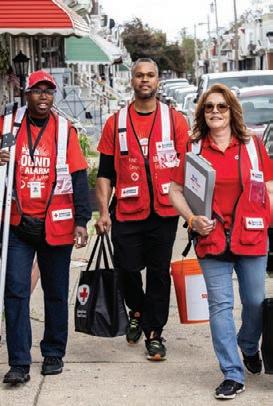



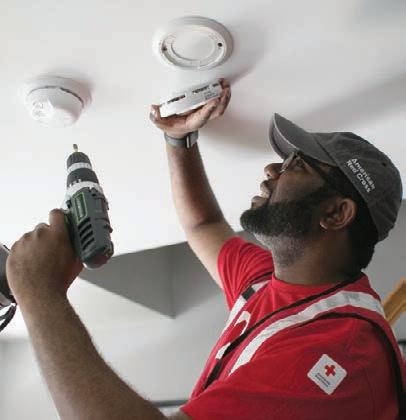
We invite you and others to join the American Red Cross mission by volunteering, giving blood, learning lifesaving skills or making a financial donation. Your support helps ensure families don’t face emergencies alone.
We invite you and others to join the American Red Cross mission by volunteering, giving blood, learning lifesaving skills or making a financial donation. Your support helps ensure families don’t face emergencies alone.
Volunteer. Give Blood. Donate. Take a Class. Visit redcross.org/AZNM to learn more.
Volunteer. Give Blood. Donate. Take a Class. Visit redcross.org/AZNM to learn more.







The SUV for the electric age is here. With a range of up to 300 miles, the all-electric Polestar 3 is designed to create remarkable range and an unmistakable look.
Visit our showroom in Fashion Square Mall.
